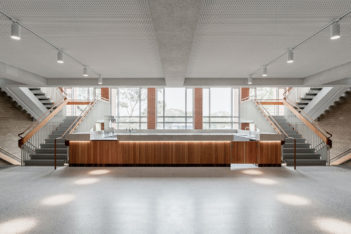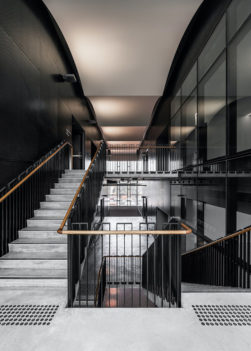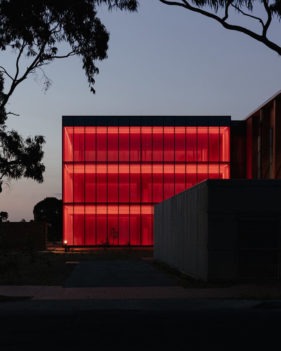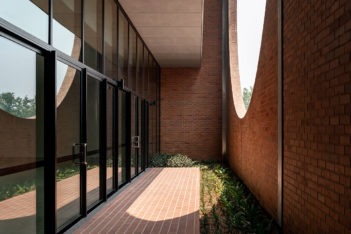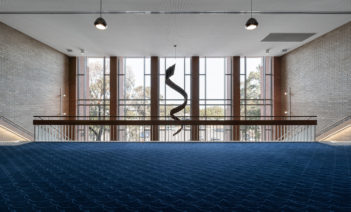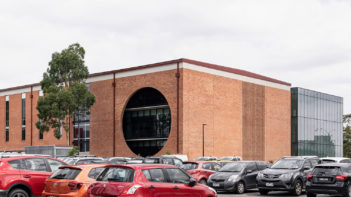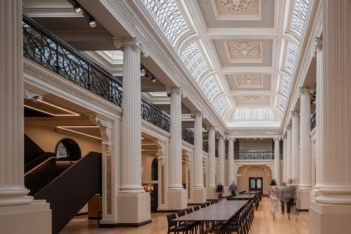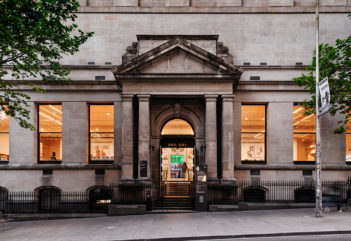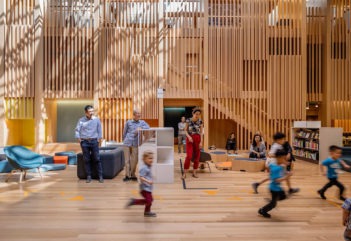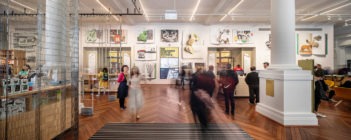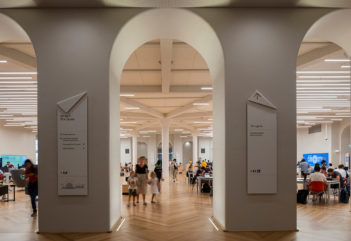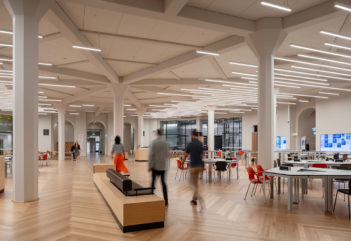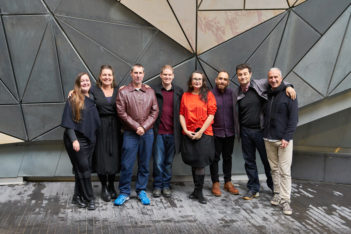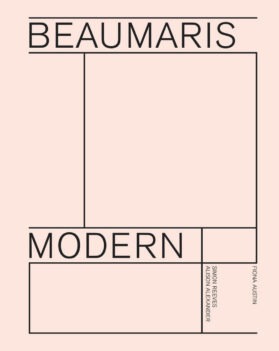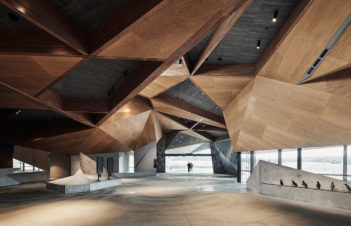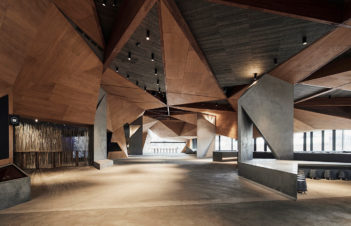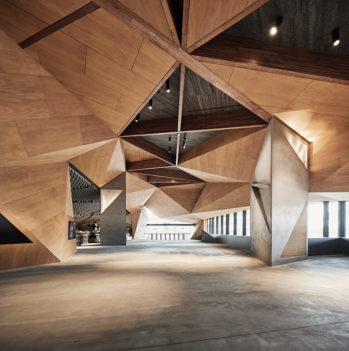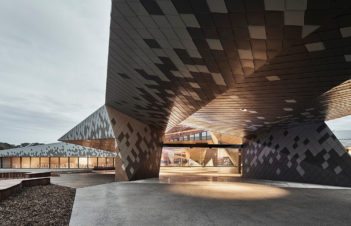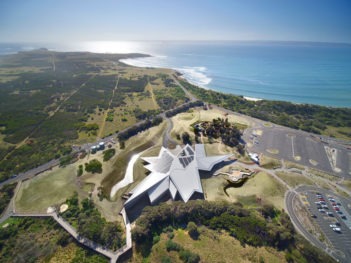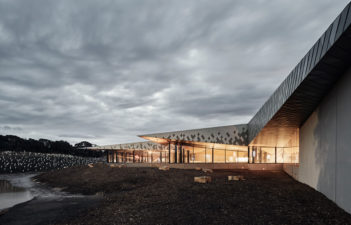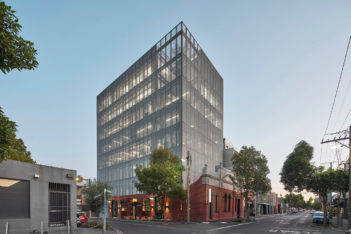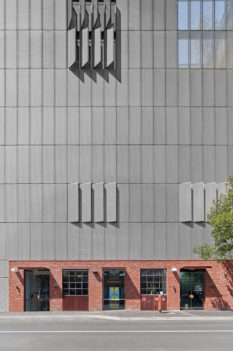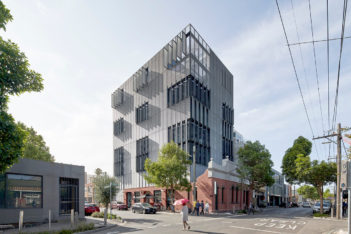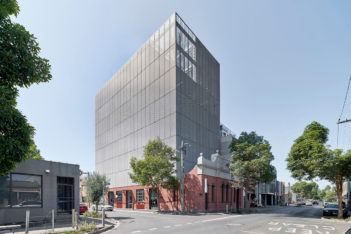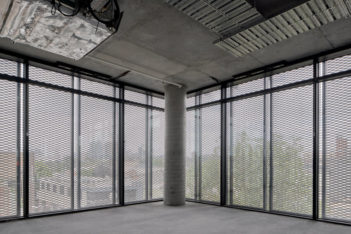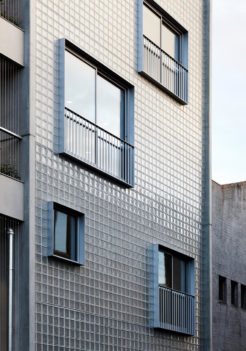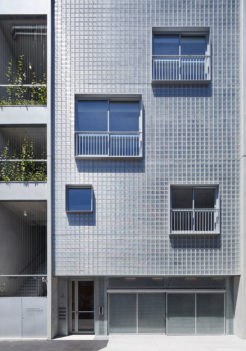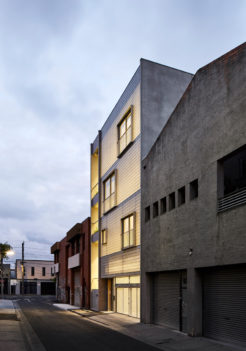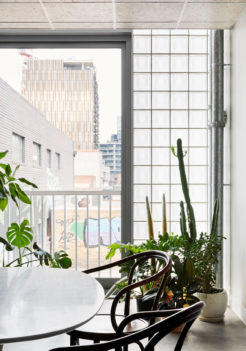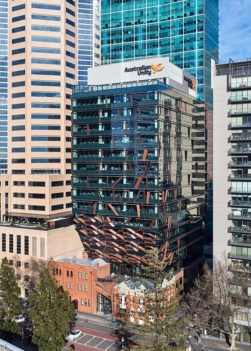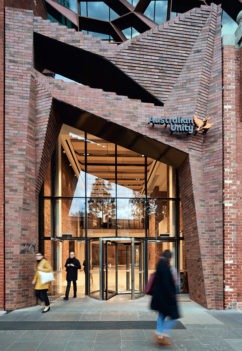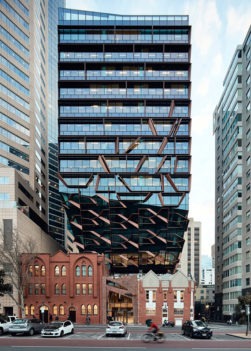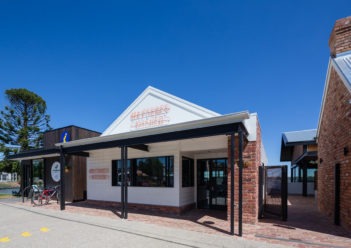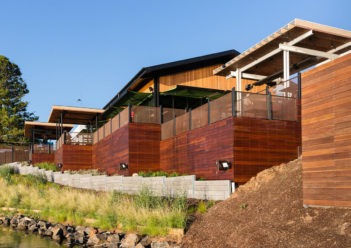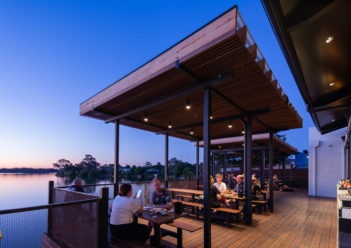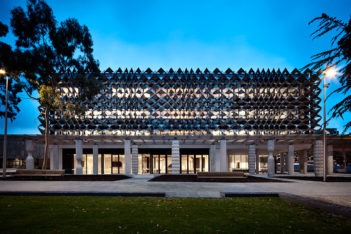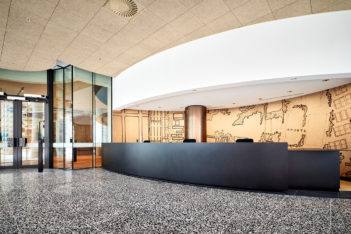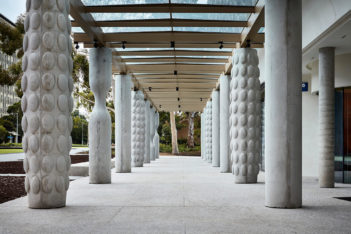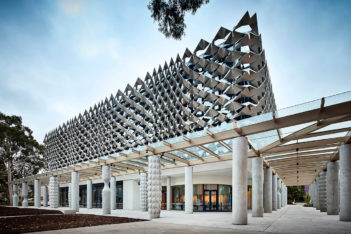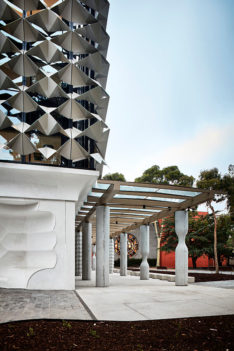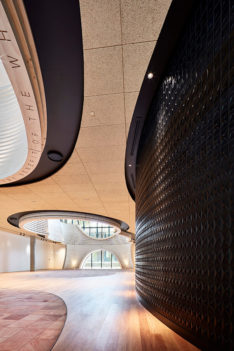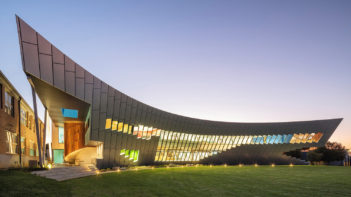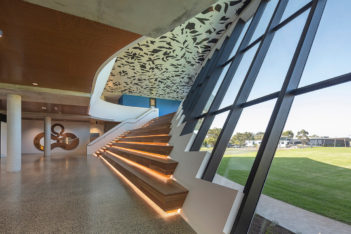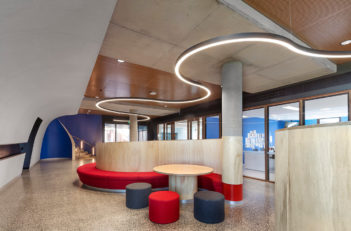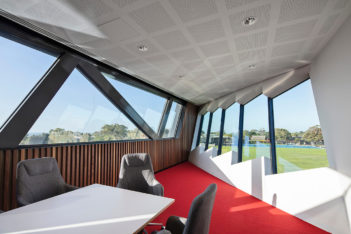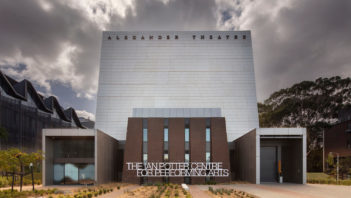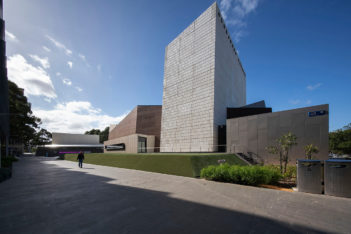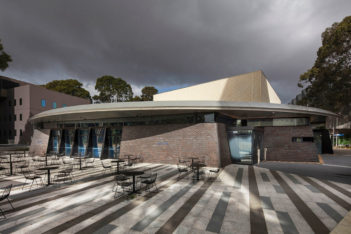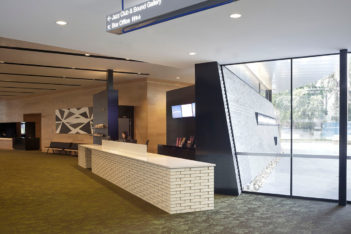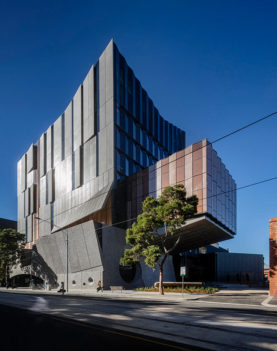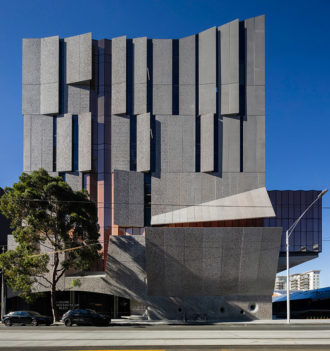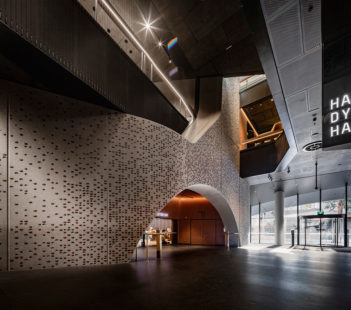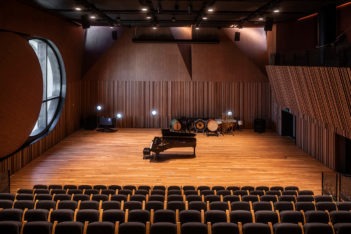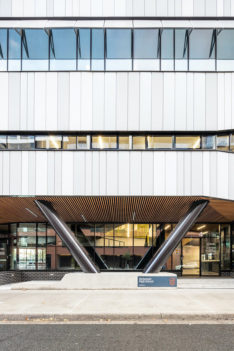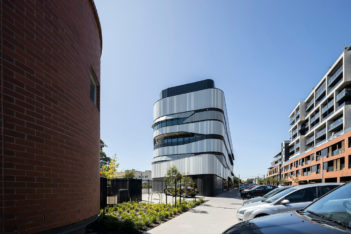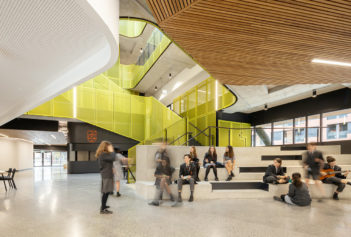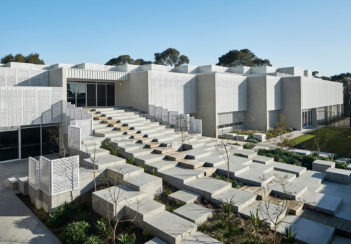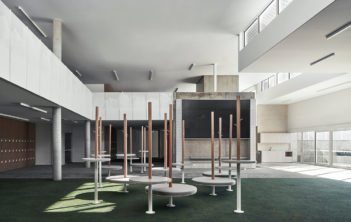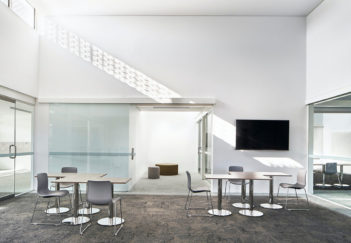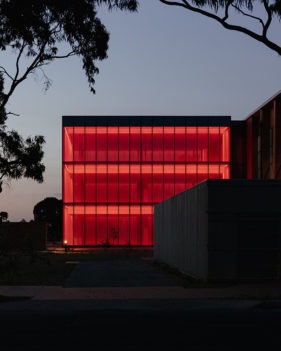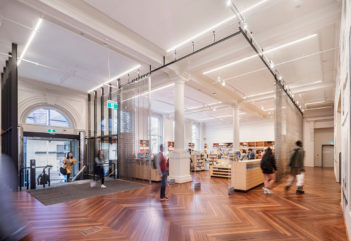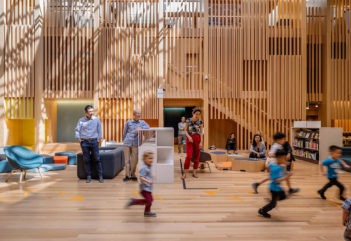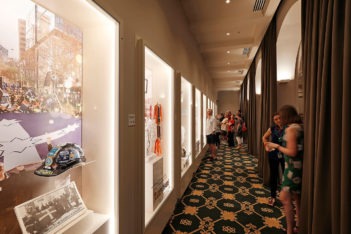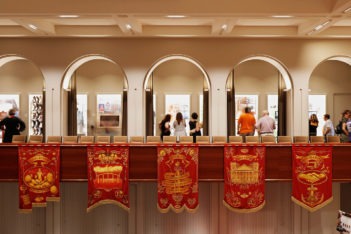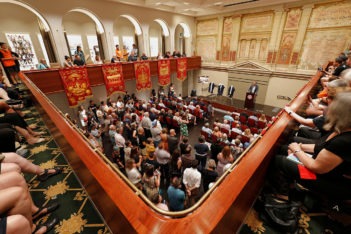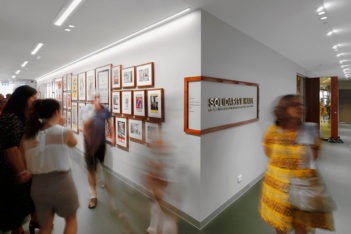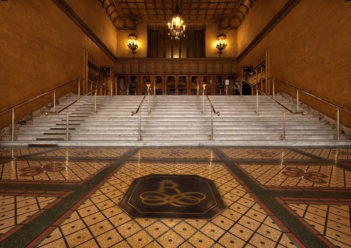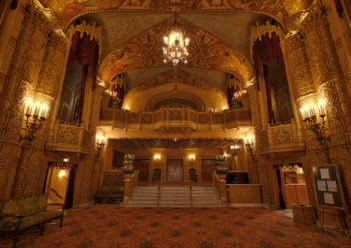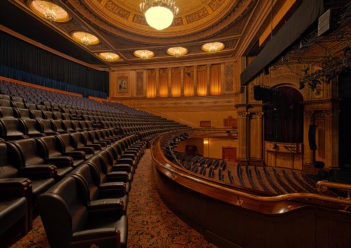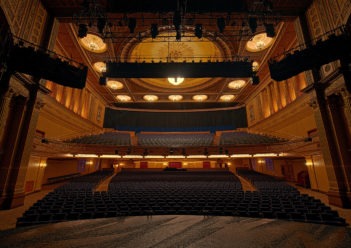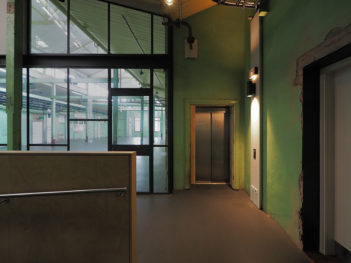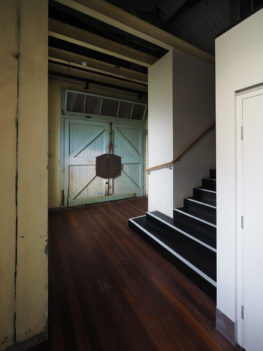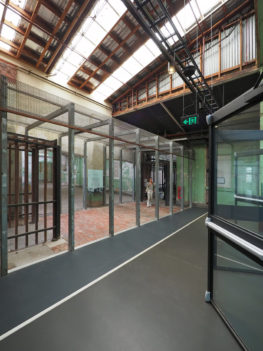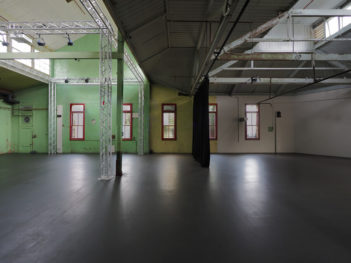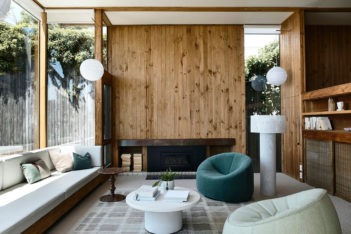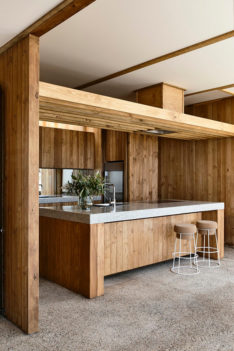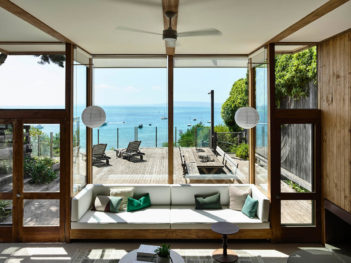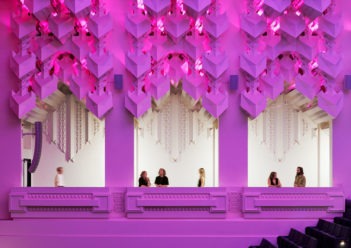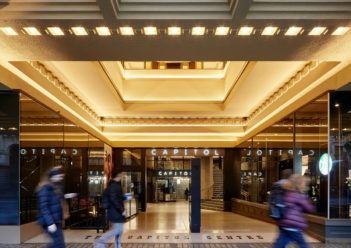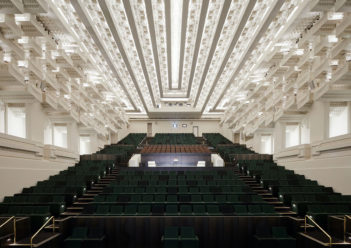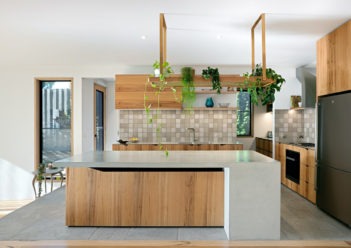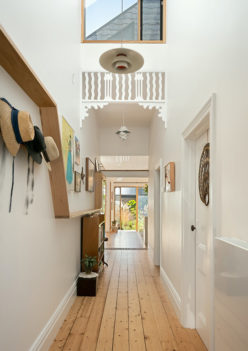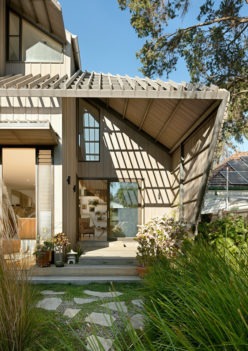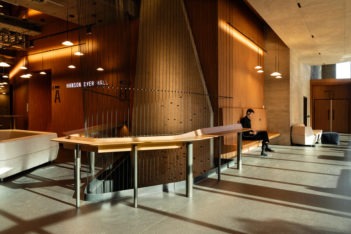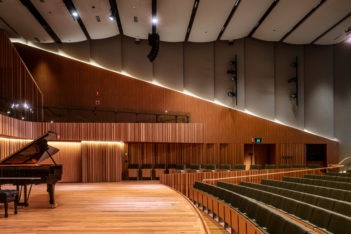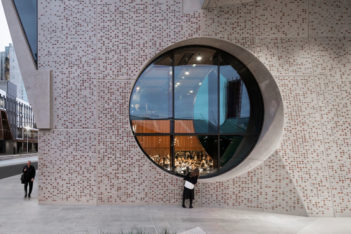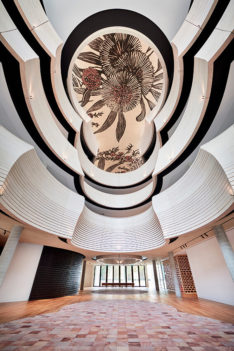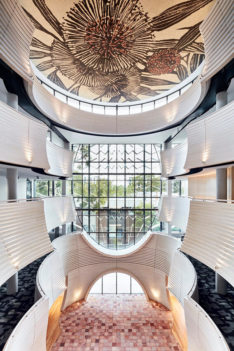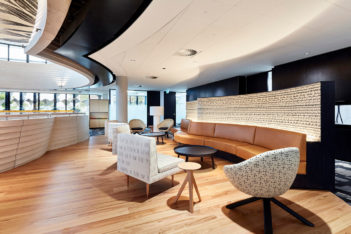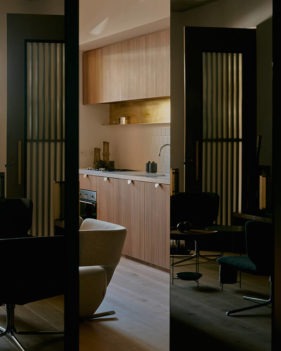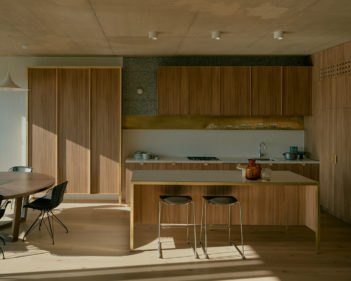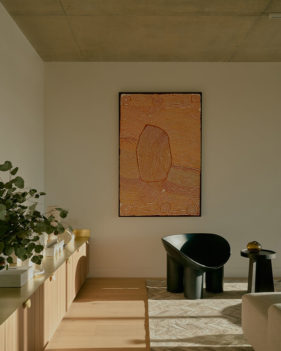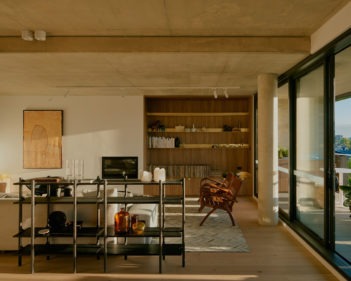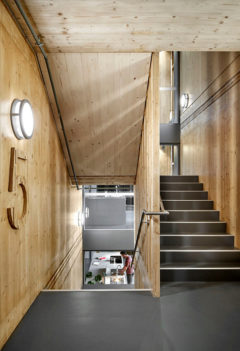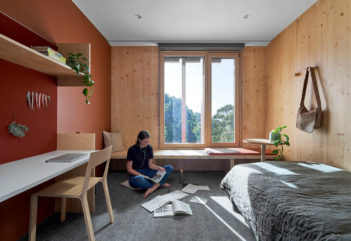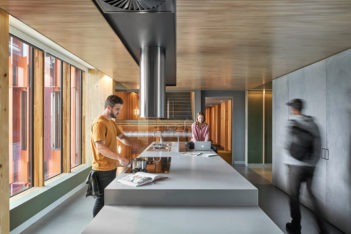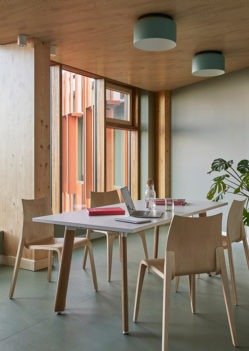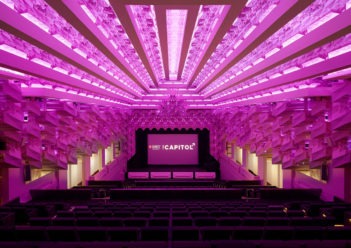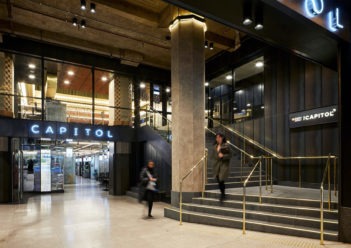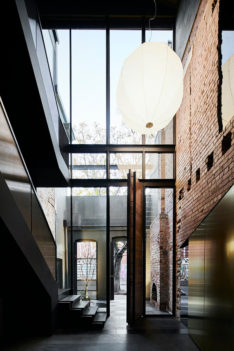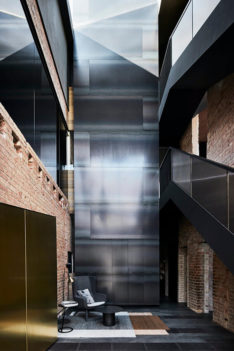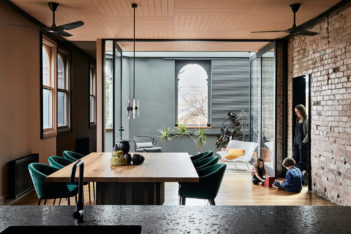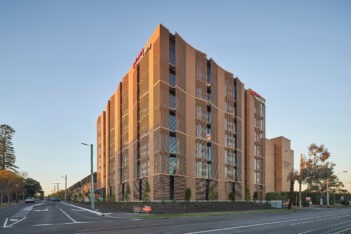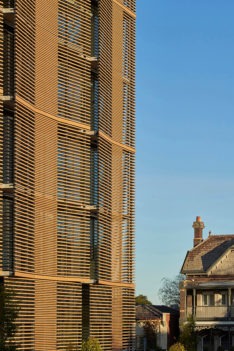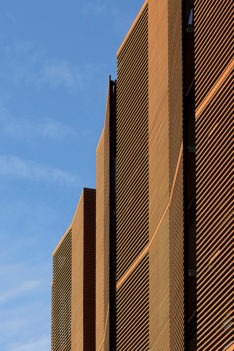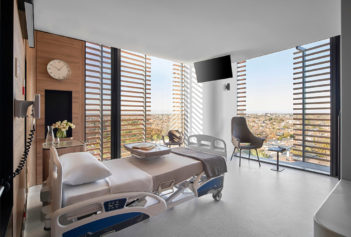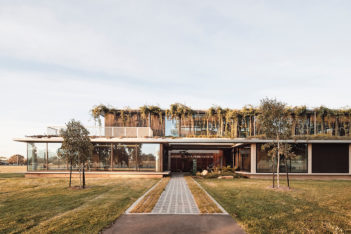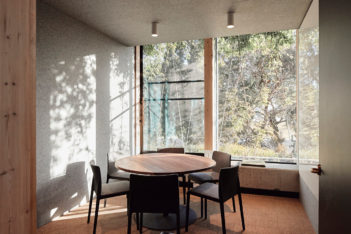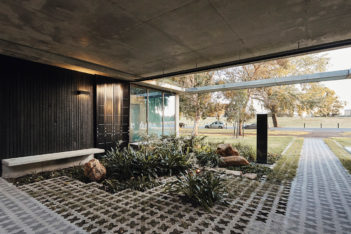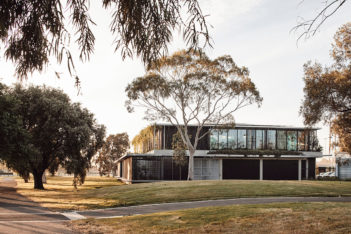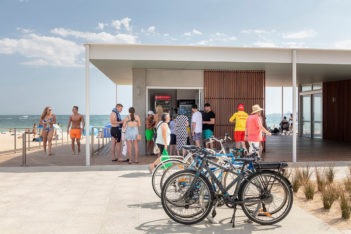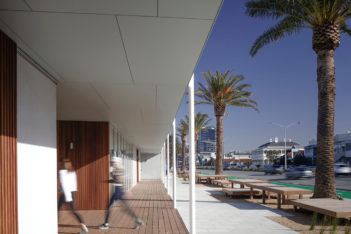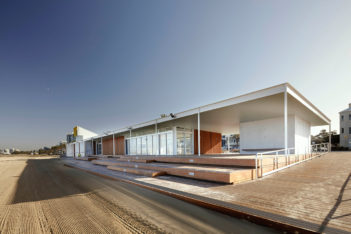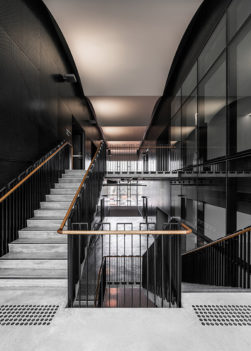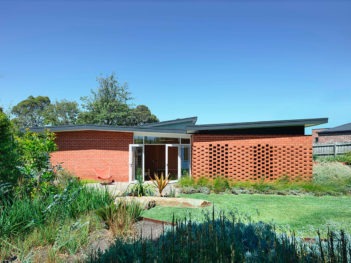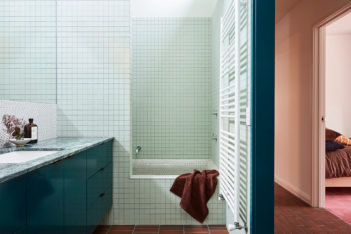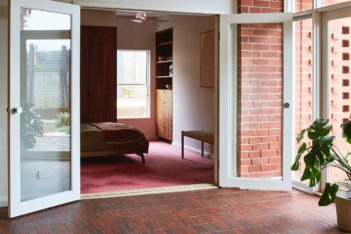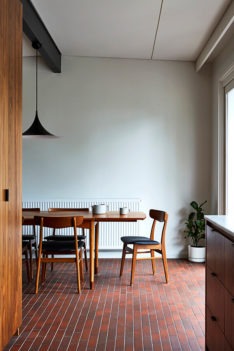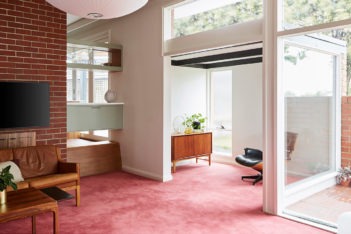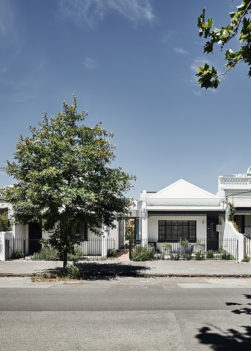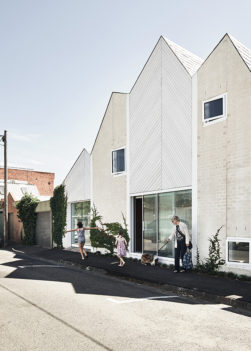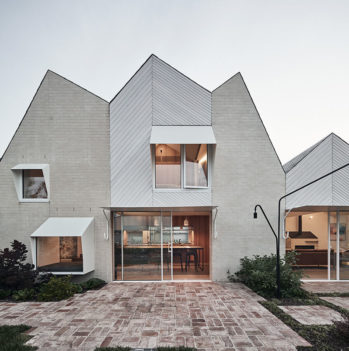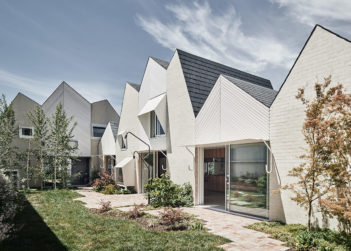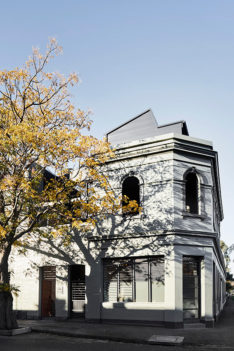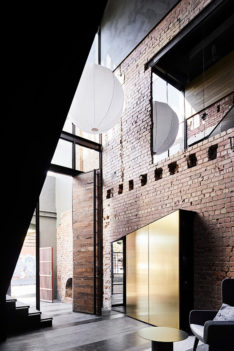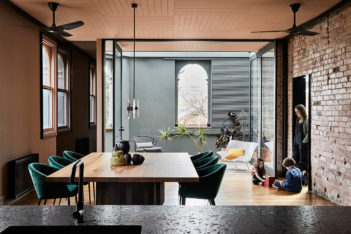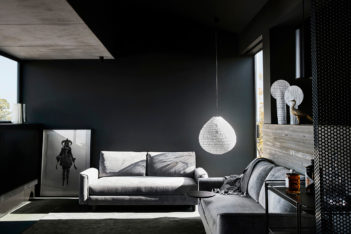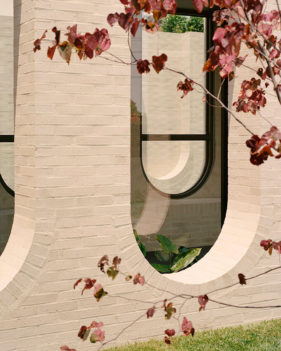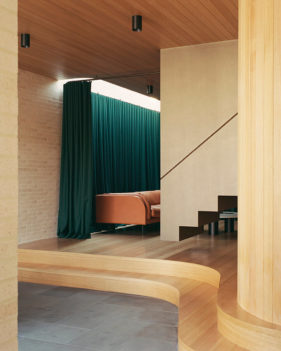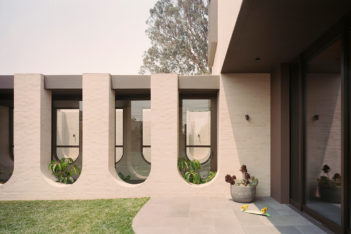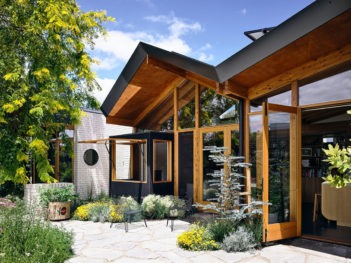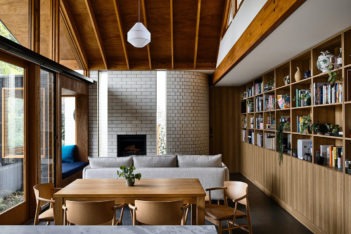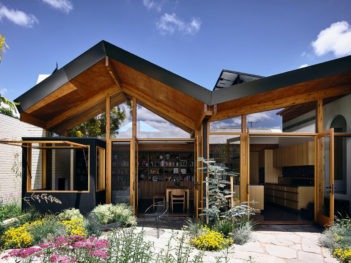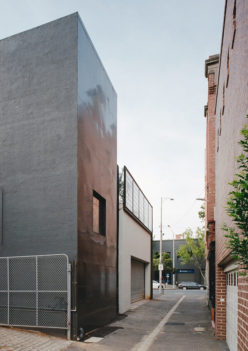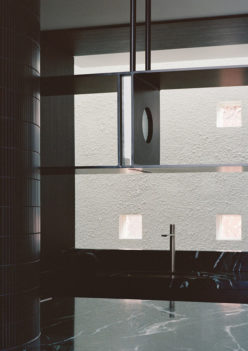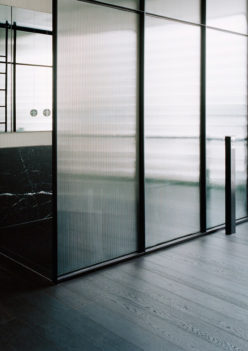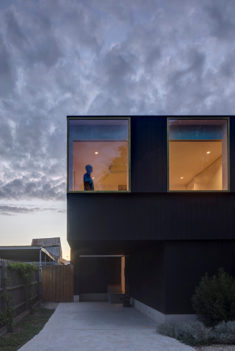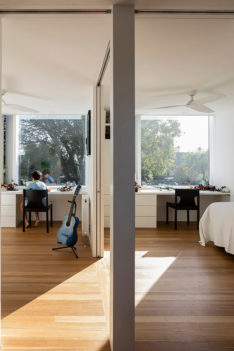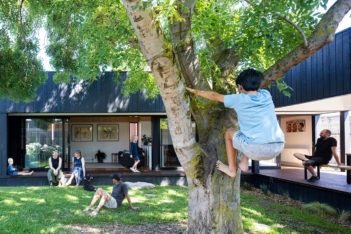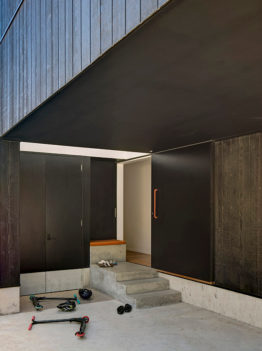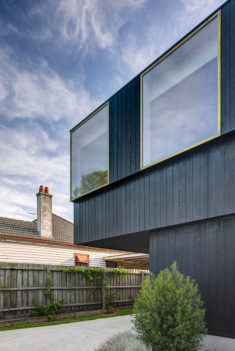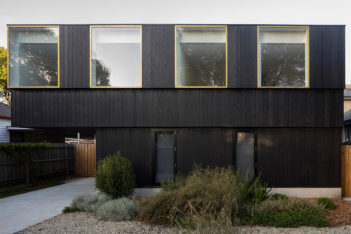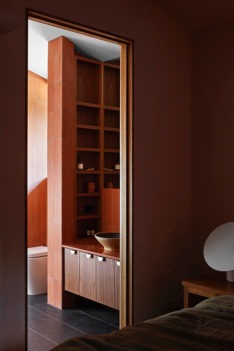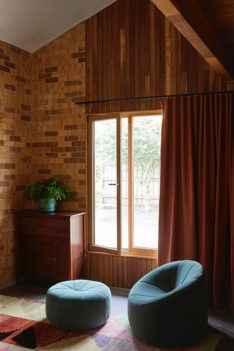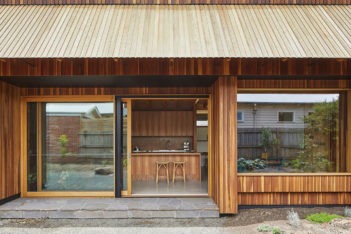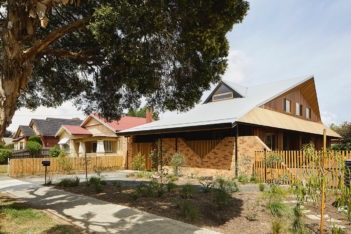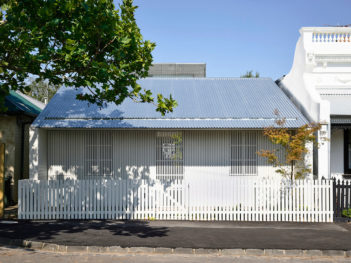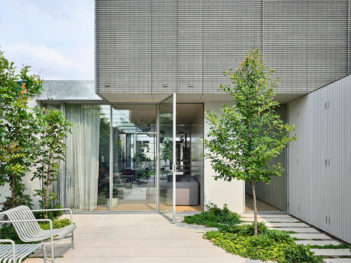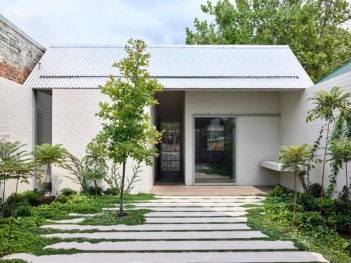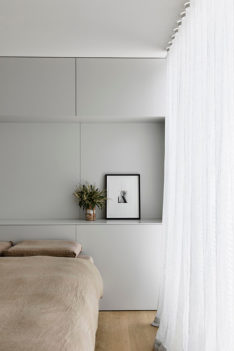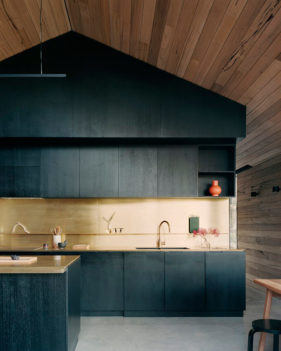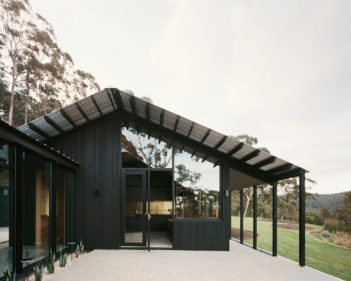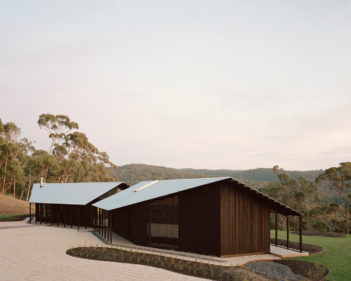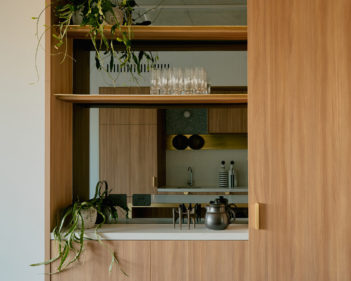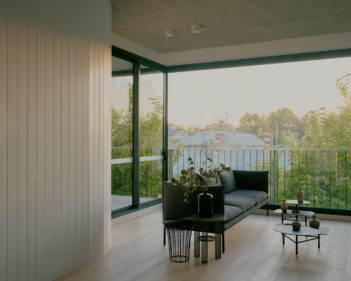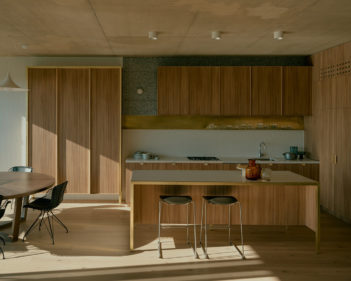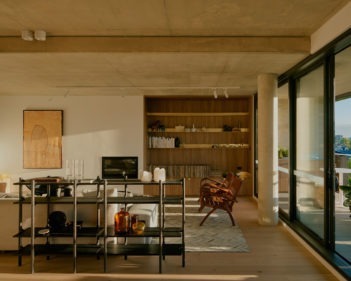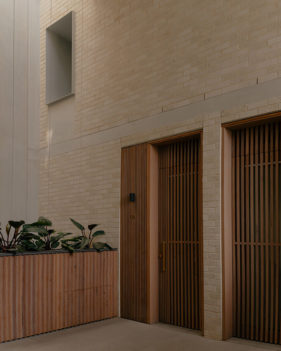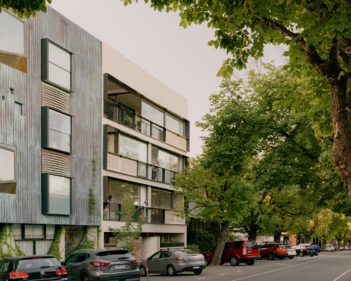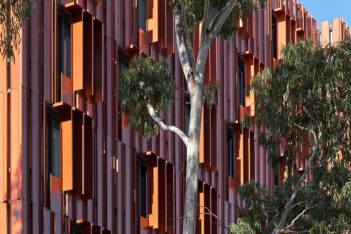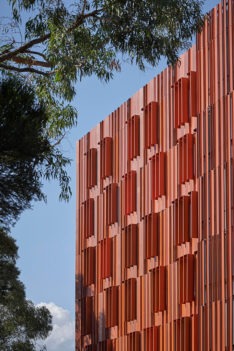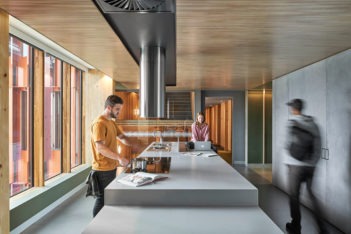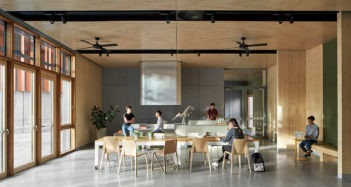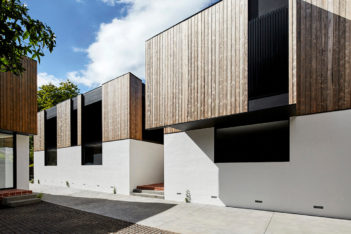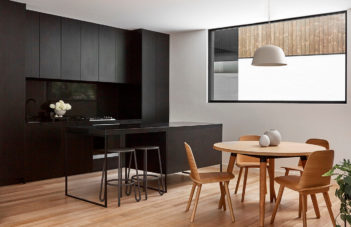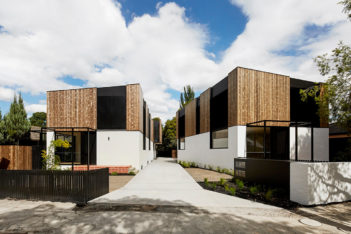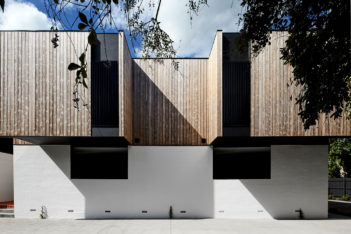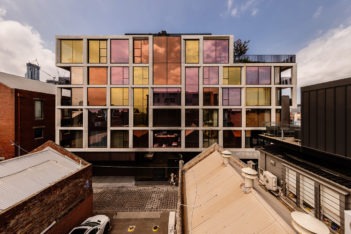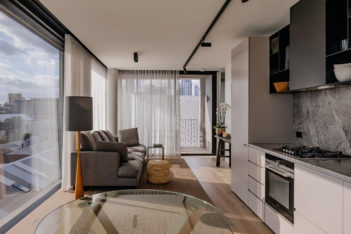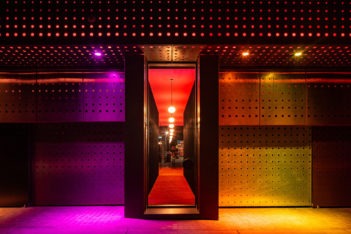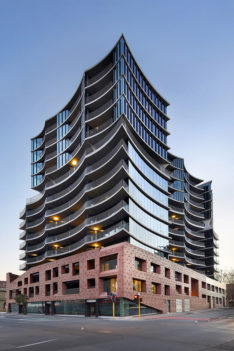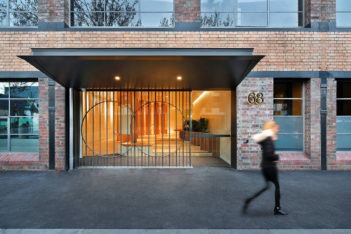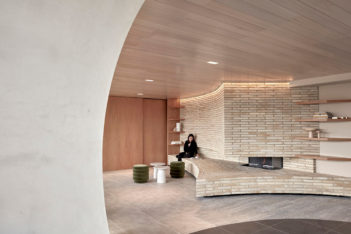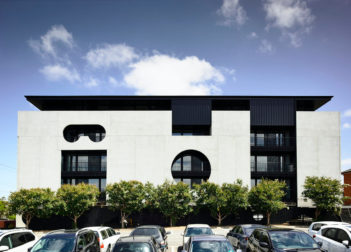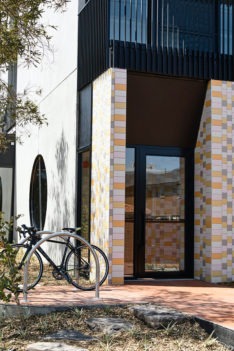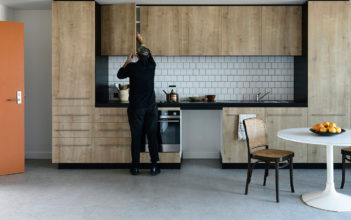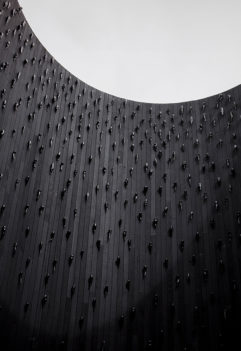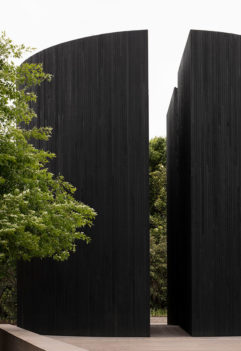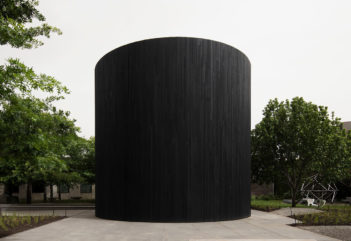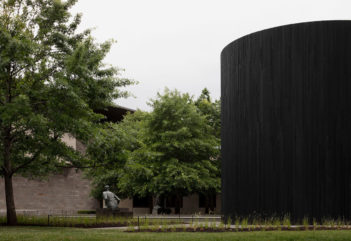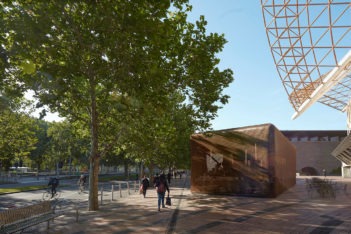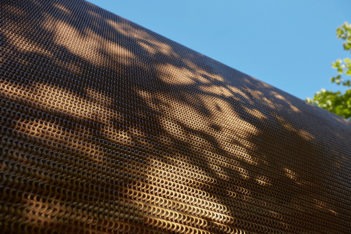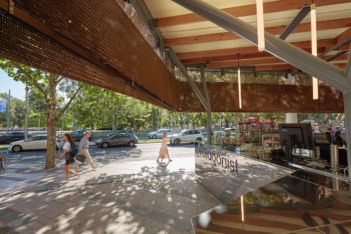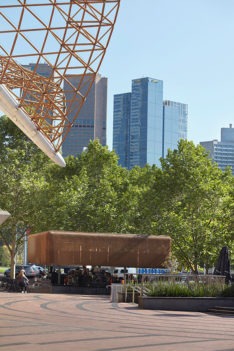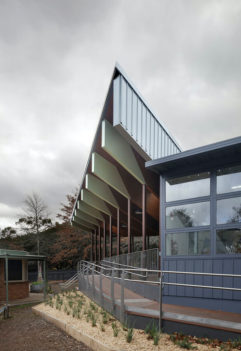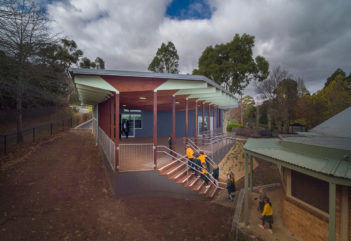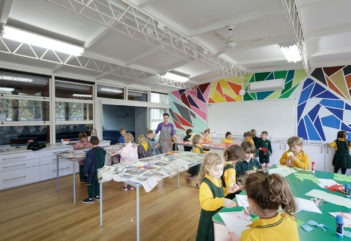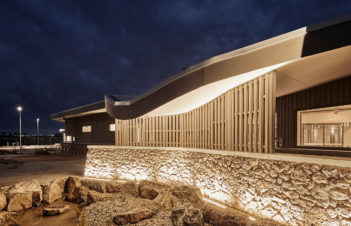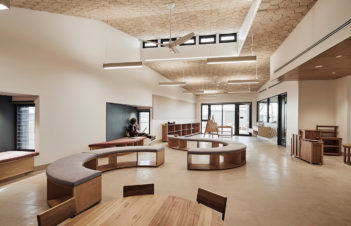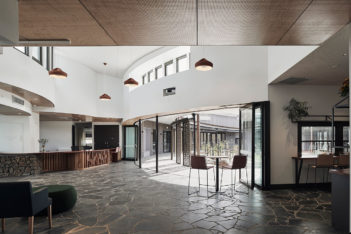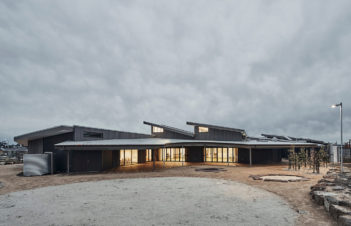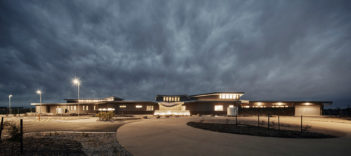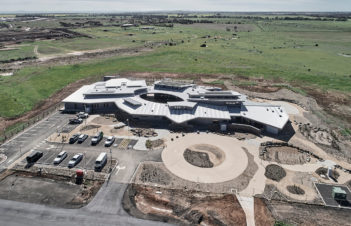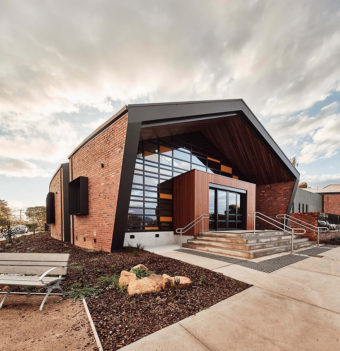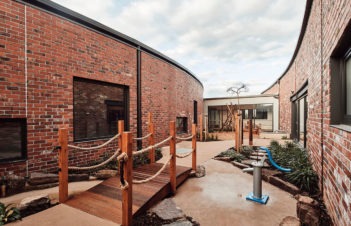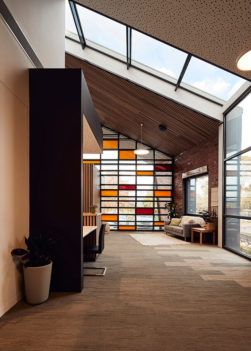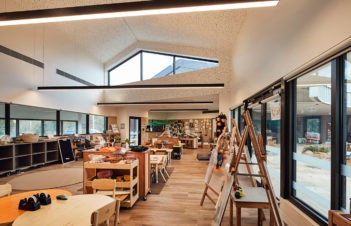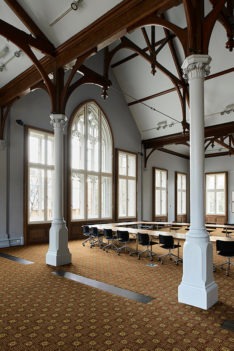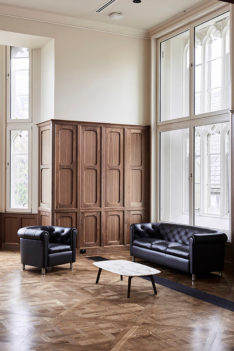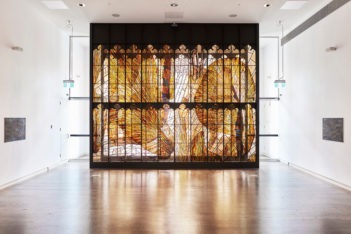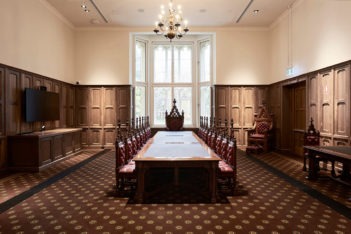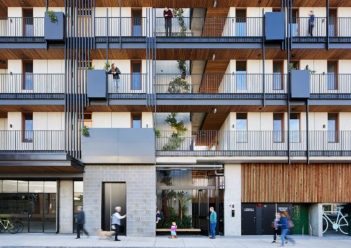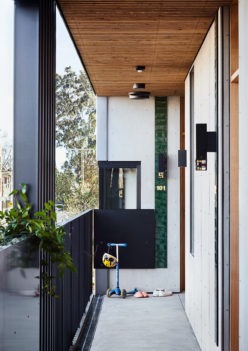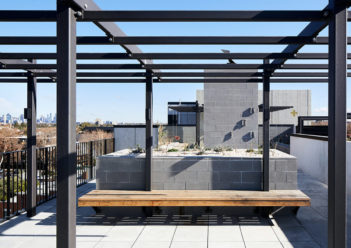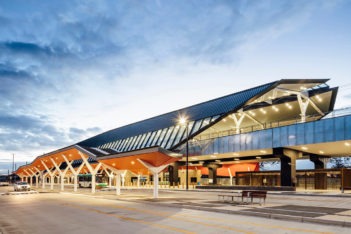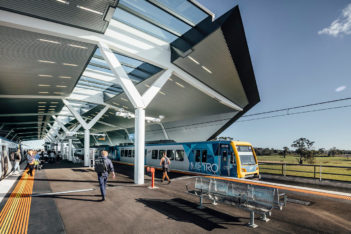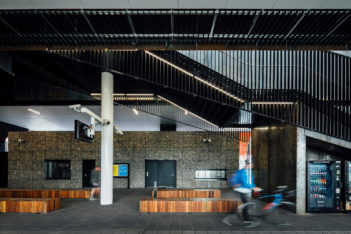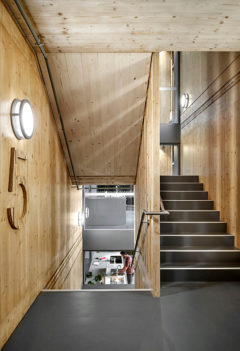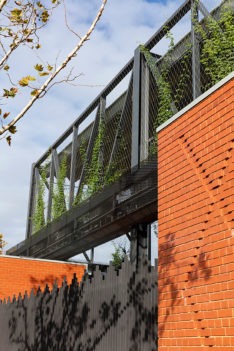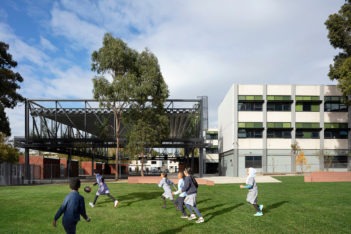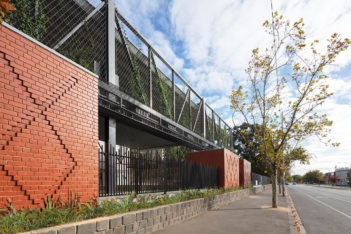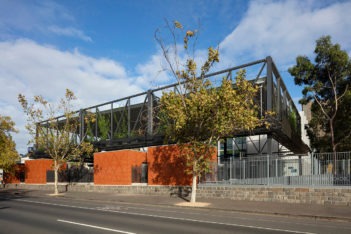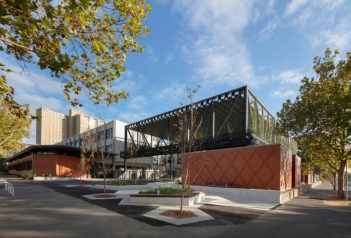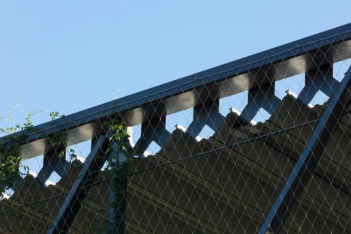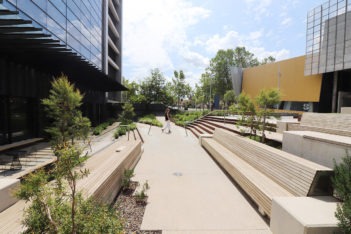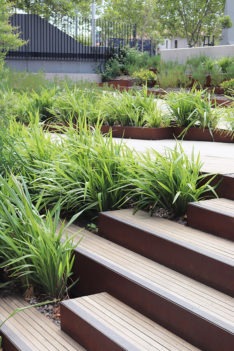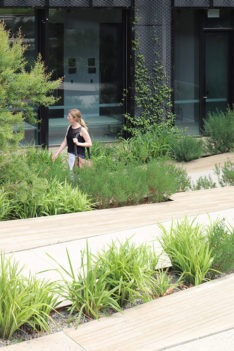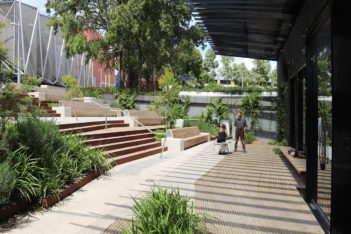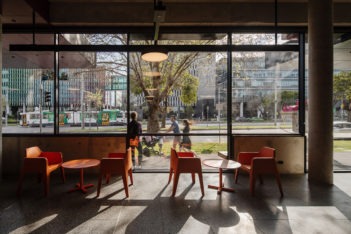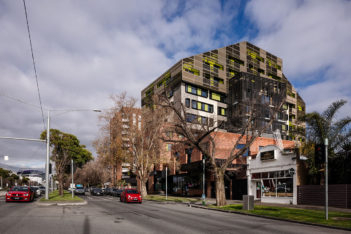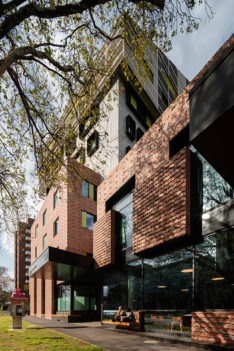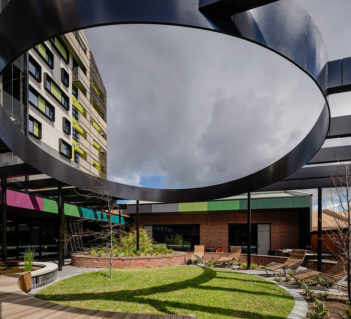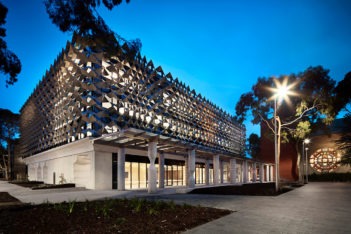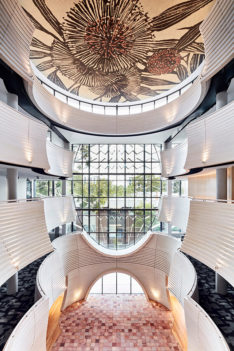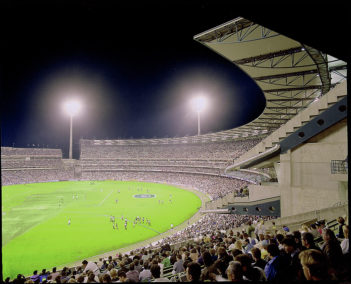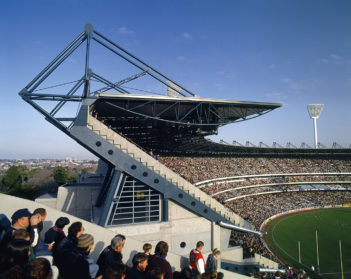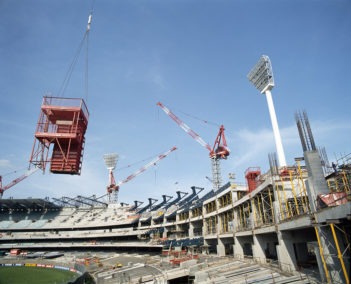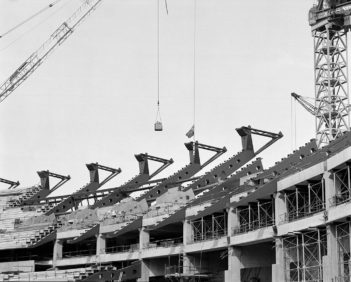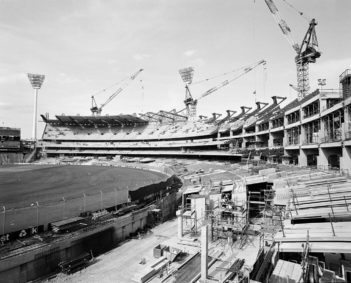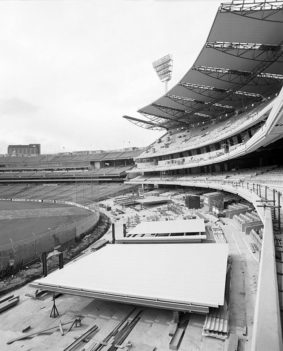2020 VICTORIA Architecture Awards Winners
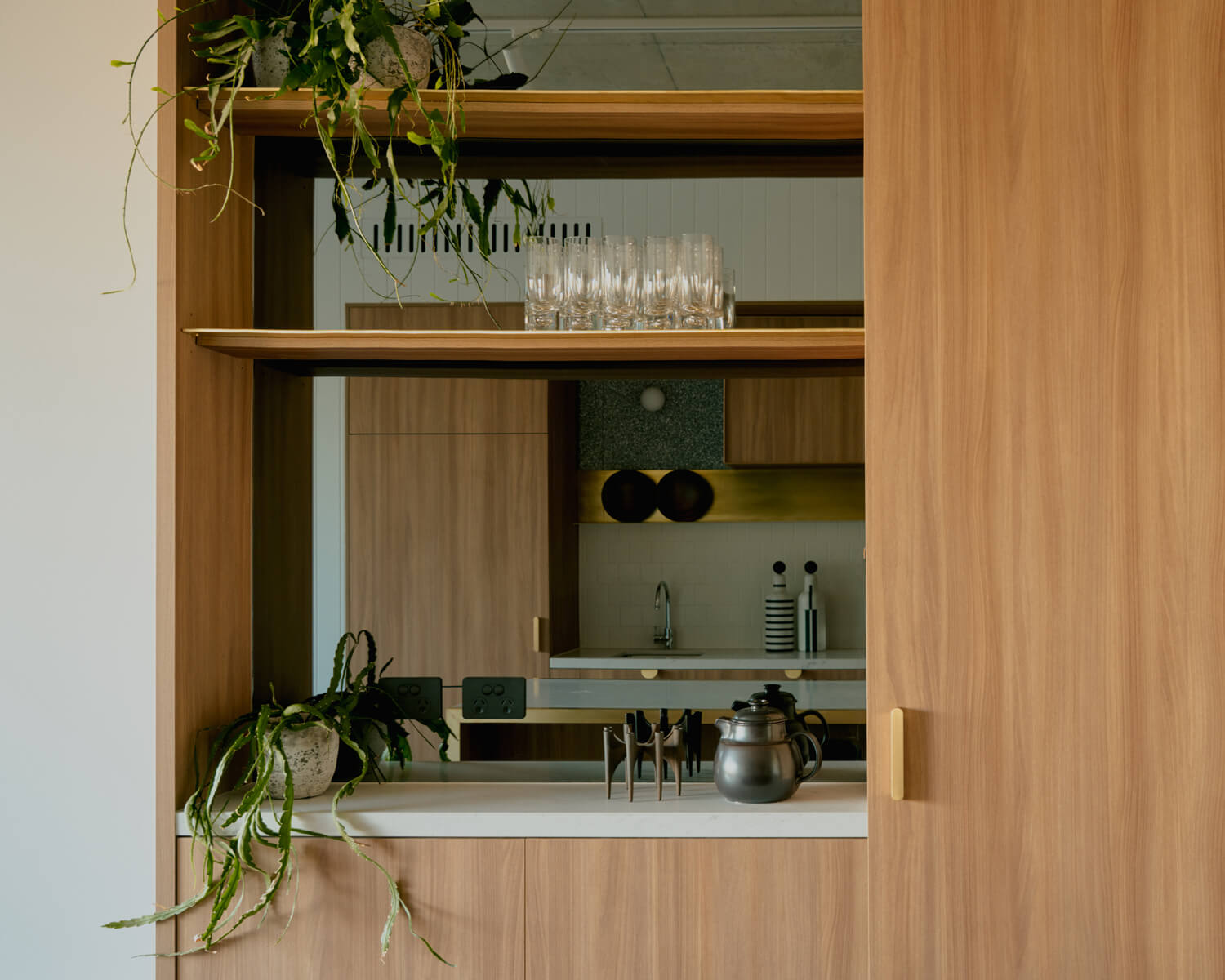
2020 National Architecture Awards
2020 Victoria Architecture Awards - results
The Australian Institute of Architects Awards program offers an opportunity for public and peer recognition of the innovative work of our Victorian architects. The program also provides the Institute with a valuable mechanism to promote architects and architecture within Victoria, across Australia and internationally.
CHAPTER SPECIFIC AWARDS
Victorian Architecture Medal
Broadmeadows Town Hall | Kerstin Thompson Architects
Congratulations all round to the winner of the 2020 Victorian Architecture Medal, to a team that embraced and realised the ambitions and vision for the project – to the local community, the client, the KTA design team, consultants and contractors. A win for the City of Hume.
Broadmeadows Town Hall is an exemplary project, that through care and forensic investigation, reinstates and re-establishes a strong civic character and heart within the City of Hume town centre. This is a project about people and places – about the local community, the local history and local identity. As an adaptive reuse and conservation project, it has skilfully integrated old and new built fabric and thoughtfully connected community pride, community spirit and community optimism with past, present and future.
From the original 1964 Town Hall designed for civic and social events, ranging from citizenship ceremonies to hot off the assembly-line car shows, to now, a 2020 landmark cultural and commercial hub, this project sets a strong precedent for understanding, celebrating and re-imagining the heritage value of our mid-century modernist suburban typologies.
Melbourne Prize
State Library Victoria Redevelopment | Architectus + Schmidt Hammer Lassen Architects
The Vision 2020 Redevelopment of the State Library of Victoria has resulted in a skilfully and soundly researched design framework which will maintain the relevance of this much loved Melbourne institution for many generations to come.
Melburnians have a strong link with the current site of the State Library of Victoria which occupies an entire central city block. The first Public Library occupied a portion of this site from 1856 onwards and has subsequently shared the site with other important cultural institutions. Since the year 2000 the State Library has occupied the entire site.
The Vision 2020 Redevelopment addresses ageing buildings, changing usage and stilted circulation. The scope of works has re-instated through- site links and welcoming entrances. Interiors have been stripped of years of building clutter and offer 40% more public access space via an easy sequential flow. Contemporary research and learning spaces respectfully acknowledge original building volumes. The original Queen’s Hall reading room has been meticulously restored, updated and re-opened to the Public following a sixteen year closure.
The architects have deftly edited layers of history and earlier renovations to reveal the building’s original character. Moments of new design introduce personality while remaining respectful of the earlier built fabric.
Bates Smart - Advocacy Award
Our City, Our Square | Citizens for Melbourne
The Our City, Our Square campaign is recognised for facilitating a successful public intervention into the planned demolition of the Yarra Building at Federation Square. While focused on a single issue, the campaign has contributed greatly to elevating public awareness around issues of process, contemporary heritage, ownership of public space and the contribution of architecture to community life.
The campaign, coordinated by Citizens for Melbourne, is broad in reach while concise in execution and displays a clear strategy across a range of media, statutory processes and public engagement. The content, events and advocacy have clarity of purpose and outcome that maximised the particular and specific qualities of the medium, including coordinating detailed planning submission alongside visually engaging and accessible print media, social media and merchandising.
Importantly, the campaign has successfully facilitated a process that is immediately accessible, with clear calls to action paired with pathways for contribution that has set a framework for continued public involvement in built environment issues.
Bates Smart - Victorian Award
Beaumaris Modern: Modernist Homes in Beaumaris | Fiona Austin; Simon Reeves; Alison Alexander; Melbourne Books
This book celebrates the cluster of excellent Modernist houses in Melbourne’s bayside suburb of Beaumaris. It is an approachable book with an admirable mission – to highlight the importance of this endangered group of houses to protect them from being demolished. This is unfortunately in contrast to the ongoing absence of local government protection of houses in this area.
The coffee table book format is co-opted here to create a book that works on two levels. It is a showcase of fine houses with stunning new photography and it is also a work of subtle activism. The book is clear and clean in its design, and the project summaries feature redrawn floor plans, albeit without north points and a consistent scale. The writing is friendly and accessible to appeal to a broad audience. Insights and anecdotes by original owners are dotted throughout, tracking the various alterations and restorations since the optimistic days of the 1950s and 60s.
The jury was impressed by the dual purpose of this publication and hopes that it has had an impact on protecting the local Beaumaris architecture.
Bates Smart - National Award
International Indigenous Design Charter | Jefa Greenaway | Russell Kennedy | Meghan Kelly and Brian Martin
The International Indigenous Design Charter serves as a self-regulated, living document to guide best practice when working with Indigenous knowledge in commercial design projects. The clarity in which this international document outlines key protocols is outstanding, making it genuinely accessible to all stakeholders – including built environment professionals, design clients, government, corporations and other businesses. In particular, the key points have been cleverly delineated from expanded descriptions, ensuring the delivery of a user-friendly document.
Rather than providing definitive answers, the charter promotes the idea of learning through active practice. Each of the ten succinct points prompts deeper thinking and inquiry, and in turn, will generate broader conversations about the appropriate expression of Indigenous knowledge beyond architecture and design. The editorial curation of the charter demonstrates commendable professional leadership, fostering excellence in cultural innovation through inclusiveness.
Regional Prize
Penguin Parade Visitor Centre | TERROIR
Generated at a convergence of dune, headland and wetland where the passage of tiny penguins pass, this new centre delivers on an extraordinary vision, providing a world class facility of architectural excellence in this tiny, significant and conservationally sensitive place.
The depth of investigation undertaken in developing the key principles of arrival, visitor movements and delivering enriched experiences is clearly evident, and is to be commended.
The rigour in the development of the building’s angular configuration, creates an outstanding experiential journey within, whereby visitors are immersed into their own remarkable path, and integrated sequentially along the building’s cavernous spine through a variety in scale and interconnection of interior spaces.
Externally, the building sleeves itself into the landscape, its long jagged horizontal forms extending the building envelope into the dunes progressively along its pathway, showing considerable understanding of, and response to its natural context.
This project has secured, protected and strengthened the future for the penguin colony, bolstering wildlife and environmental conservation on Phillip Island, and enhancing its regional tourist destination.
The Penguin Parade Visitor Centre is an exceptional building of integrity, detail, resolution and architectural excellence.
Emerging Architecture Prize
Thom McKenzie | Winwood McKenzie Architecture
Thom Mckenzie is the perfectly balanced architect who continues to advance architecture through his practice, teaching and research.
Establishing Winwood Mckenzie in 2011 after working for some notable local and international practices, Thom produces architecture that contributes to the cultural landscape of Australia. A series of sensitive alterations and additions strongly underpins an office built from the ground up. As an architect’s portfolio grows, the method around brief, context and history of place is tested. Thom’s beautifully resolved projects hold the practice’s future in excellent stead.
Thom has managed to combine this with an intense contribution to the Institute and teaching. Currently at the Institute, Thom is an International Chapter Councillor, but has also fulfilled roles as the National President of EmAGN, a National Councillor, a Chapter Councillor, a National Education Committee member, Chair of the Victorian EmAGN committee and SONA representative at the University of Melbourne. In 2019 Thom co-produced the Hearing Architecture podcast for the Institute which has had more than 3500 downloads, expanding the reach of public discourse for contemporary Australian architecture to a national and international audience. Thom’s ongoing commitment to the Institute speaks volumes to his generous and passionate commitment to the profession.
Maintaining a strong interest in architectural education, Thom is in high demand from Victoria’s major universities. Thom is the Professional Practice lecturer at Monash University and has led a number of design studios at RMIT University, Monash University, and the University of Melbourne. His ongoing passion for research and teaching maintains the highest of standards for current emerging architects, and also speaks to his invaluable commitment to inspire future generations of architects.
Jury Members
Amy Muir – Chair
Rodney Eggleston
Sophie Cleland
Gumji Kang
commercial
The Sir Osborn McCutcheon Award for Commercial Architecture
9 Cremorne St | Fieldwork
Each design move in 9 Cremorne Street has been undertaken with decisiveness and precision.
Occupying a tight city fringe site with a historically significant early Edwardian factory, this is an office building designed for Australian conditions. Above the warmth and reassuring simplicity found in the brickwork of the heritage base sits a strong, fully screened, rectangular volume. It is a building that dynamically responds to the changing environment while dealing sensitively with the existing heritage fabric. It is a corner bookmark, marking the gateway into the Cremorne Precinct
Wrapped in expanded metal screens the building’s appearance can change throughout the day as these screens give the occupants the ability to adapt their workplace to suit their environmental preferences. It gives an ephemeral effect to the simple form but more importantly an immediacy and intimacy to the interior work spaces.
It is an outstanding example of how to balance all the differing issues and constraints a project provides. It creates a great place for people to work, a built identity for a company and positive contribution to our developing urban environment. It does this while demonstrating how a sustainable approach can be a strong and beautiful architectural statement.
Award for Commercial Architecture
Light Box | Clare Cousins Architects
On a highly constrained site with only one façade receiving direct light, the project successfully delivers an outcome that is focussed on tenant wellbeing. The key move in the project is the use of glass bricks across the majority of its façade. This delivers a beguiling outcome, at night the façade glows, acting as a beacon within the streetscape. Arranged across this elevation at each level are operable glazed screens which open onto juliette balconies. This provides an attractive opportunity for user control. Within the building and to the rear of the floorplate a full height light well draws light deep into the floorplate and is naturally ventilated. A kitchenette and adjacent room provides spatial complexity and flexibility. Light and air is also drawn into the building via the full height open fire stair fronting the street. In time creepers will grow up the face of this stair, acting as a soft counterpoint to the adjacent glazed façade. This is a highly successful scheme which should act as a prototype for other commercial projects due to the deft manner in which it has provided access to natural ventilation, direct light, nature and greater levels of user control.
Commendation for Commercial Architecture
271 Spring Street | John Wardle Architects
271 Spring Street retains, reveals and expands upon the history of its site to create a new workplace revelling with its place in the city.
This building incorporates a brick podium that is both heritage and reimagined and includes the Elms Hotel and the Mission Building.
A two-storey brickwork streetscape is scaled for people and materials are consistent with its neighbours creating an engaging relationship with passers-by.
Separate from the brick podium is the office tower, curtain walls incorporate sun shading to improve thermal performance. Expanding this texture further, the patterns of historic roofs hidden from view are writ large upon the inclined glass face of the tower above.
The site’s constraints were complex. The structure responds to heritage facades, electrical infrastructure easements, adjacent buildings and the underground rail link tunnels directly below the site. The resultant structural frame is uniquely shaped – a very specific response to its context.
Commendation for Commercial Architecture
Nagambie Brewery & Distillery | Six Degrees Architects
The Nagambie Brewery project is a new hospitality precinct located on the shores of Lake Nagambie. Designed by Six degrees, the Project consists of a Tourist information centre, a Café, A Brewery, Distillery, Whisky bar and Restaurant. Nagambie has experienced a decline in recent history, however Owner Gerry Ryan was committed to bringing contemporary hospitality design to Nagambie, and providing an offer all year round.
The new buildings respond to the scale and diversity of the main street, however they also lead patrons to the discovery of the underappreciated lake frontage. The design opens up to the lake with multipole decks further enhancing the water experience. Since its completion in 2018 The Brewery has exceeded all expectations with regard to visitations, resulting in a positive flow on effect to other local businesses.
Educational Architecture
The Henry Bastow Award for Educational Architecture
Monash University Chancellery | ARM Architecture
The new Chancellery building at Monash University is a thoughtful, collaborative, well executed, crafted piece of Architecture. It combines administrative office space with a variety of accessible community functions, providing a ceremonial centre piece for the University. As a building in the round it responds to its context playfully and intelligently with an open and inviting presence that successfully encapsulates the architects’ desire to conceptualise the intellect, diversity, and values of the 21st century university. It has, by design, facilitated a more collegial style of collaborative working within the university’s administration, and opened the chancellery to the wider university community. The project produces a visually stimulating and tactile environment that integrates a culturally diverse collection of artworks into the building fabric. The services design and interior detailing is skilful and combined with the overall quality of the building’s resolution, expresses the necessary rigor, attention to detail and perseverance required to produce an exemplary piece of environmentally responsive architecture that has regard for its genius loci. It set the benchmark amongst the entries for its approach to sustainable design and building technology, having been designed to ‘passive haus’ principles, while allowing the Atrium to be opened up and naturally ventilated for ceremonial occasions, showing an understanding in adapting the technology for local conditions.
Award for Educational Architecture
The Swift Science and Technology Centre | McBride Charles Ryan
The SWIFT Science and Technology Centre is a well-considered building containing an array of teaching and learning experiences. The architecture engages and immerses students at every step in STEM (Science, Technology, Engineering, and Mathematics) disciplines. McBride Charles Ryan has been awarded for their skill in producing a diverse collection of teaching and learning spaces, within the building’s laboratory and ancillary spaces.
The architects have successfully created a space that engages students, teachers, and the broader community through excellence in design, in the context of the school and its design history. The building itself creates a new grandstand end to the southern perimeter of the campus. Its faceted curvaceous façade introduces a new focus to the surrounding outdoor areas. The Edna Walling motifs reference the school’s rich landscape history.
The architects described the making, display & understanding as critical to their design process, evidenced throughout spaces, either partially or fully glazed internally. The new building forms a connector between the high and junior schools with all students free to witness the learning within.
Award for Educational Architecture
Monash University Ian Potter Centre for Performing Arts | Peter Elliott Architecture + Urban Design
The Ian Potter Centre for Performing Arts at Monash University is a skilful and highly crafted example of adaptive reuse of a significant building. The original Alexander Theatre or ‘The Alex’ as it is affectionately known has been incorporated through skilful planning and architectural interventions into a larger complex of complementary and alternative performance venues. Peter Elliott Architecture and Urban Design are to be commended, not just for the refined detailing and clarity of design resolution of this project, but for engaging with their client and fighting to retain the ‘Alex’ which was a crucible for the 1960’s avant-garde theatre scene and student events. Slated for demolition, this heroic piece of architecture has been painstakingly brought back to its former glory to reclaim its role of attracting and nurturing world-class talent. It has been reinstated as a jewel in the crown of the Monash Clayton campus, offering an exemplar illustration of post-war architecture, reinvented for contemporary use. The tapering monolithic form of the original Proscenium arch has been repeated in the new additions, generating an almost ancient Mycenean composition of angling forms, where each junction has been carefully resolved and meticulously detailed, creating an exemplary in-the-round building, enriching campus life from every angle.
Award for Educational Architecture
Ian Potter Southbank Centre, University of Melbourne | John Wardle Architects
The Ian Potter Southbank Centre is a unique and engaging facility for the university on a tight and challenging site, that combines music performance, rehearsal and teaching spaces with great skill and vision. As a building, this project is crafted with a keen attention to detail, that culminates in the creative use of precast concrete as artwork and artifact. The organisation of the auditoria and teaching spaces vertically, responds intelligently to the complexities of site and program. The Architect has balanced the need for acoustically tuned spaces with a dynamic learning environment. The introduction of one-way sound spill from the studios to the corridors creates a sense of activity and adds audible life to the facility creating a greater sense of community and accountability between the students. Externally, the creation of a fourth stage below the cantilever of the Hanson Dyer Hall creates an intimately scaled focal point for public performance that animates the adjacent public space. Driven to promote curiosity and awareness of the art from the public realm, the architects’ solution to the complex problem of trying to visually connect the activities within a traditional ‘black box’ acoustically ‘tuned’ studio with the community has produced a marvellous two way theatrical experience between artist and passer-by that will continue to intrigue for years to come.
Commendation for Educational Architecture
Richmond High School | Hayball
The new Richmond High School is designed around three foundational drivers: contemporary pedagogy, community enhancement and architectural excellence.
Responding positively to the restrictions of an inner urban site, the curved triangular four-storey building adds specialist areas for science, technology and the arts that are sandwiched between two floors for general learning to empowers the school’s various methods of modern learning. The atrium is the building’s structural core, minimising the need for internal columns that might get in the way of learning, as well as providing natural daylight and ventilation across all floor levels.
The flexible spaces can be adapted for numerous activities and group sizes. The main stairs are open, with generous space for social gathering, performance or discussion. The ground floor is largely reserved for communal facilities such as the library, performing arts facilities and food spaces that connect to the outdoors. Accessible by the local community.
Commendation for Educational Architecture
GPFLA LEARNING CENTRE | BRANCH STUDIO ARCHITECTS
Located at St Francis Xavier College Beaconsfield, the GPFLA Learning Centre consists of 18 new classrooms, associated learning commons, break-out areas and landscapes.
The project was imagined as a ‘Learning Landscape’ extending itself amongst the left-over spaces between the existing buildings and site boundary.
To further develop the College’s ‘flexible’ pedagogy practices an alternative classroom model was conceived incorporating a central learning core flanked by multiple, interconnected ‘break-out’ spaces grafted onto, and directly linking, these cores.
The classroom module was rationalised into an interlocking ‘cell’ and then arranged across the site – stacking along the site boundary. This language was also used to rationalise the integrated landscaped spaces.
Influencing the formal areas of the landscape was the requirement for direct access to Level 1 from the main courtyard. In response, a series of external terraces functioning as a stairway and also as a sequence of informal learning & social areas was imagined.
Heritage Architecture
The John George Knight Award for Heritage Architecture
Broadmeadows Town Hall | Kerstin Thompson Architects
Constructed in 1964 and designed by the hitherto relatively unknown architects, Murray, Forster & Walsh, The Broadmeadows Town Hall refurbishment project is an exemplar of both conservation and adaptive reuse of a mid-century modernist former town hall and municipal offices which had become obsolete and was on the cusp of demolition.
Mid-century architecture globally is just beginning to become more widely recognised as being of heritage value. Being stylistically so distinct from its predecessors and in terms of history, relatively recent, this epoch is providing heritage practitioners and authorities alike with many exciting challenges, including, as in this instance, the not uncommon circumstance of a lack of any formal statutory heritage recognition.
The Broadmeadows Town Hall, fondly locally named the Pink Elephant, was saved and revived by local community sentiment combined with the powerful and comprehensive deep research by kta to establish the heritage values of the place, not just the purely architectural aesthetic, but the associative intangible social values, and to capture and enhance them. Once equipped with this core knowledge, kta were in a position to confidently both critically conserve and also to boldly add to the complex, bringing it up code, providing legible interpretive experiences and guaranteeing the place a sustainable future, all resulting in an outstanding, but sensitive revival. And all without imposed statutory heritage controls. It is a remarkable and ground breaking project.
Award for Heritage Architecture - Conservation
State Library Victoria Redevelopment | Architectus + Schmidt Hammer Lassen
While this massive investment in one of our most treasured 19th century civic landmarks inevitably involved substantial new programming and associated adaptive reuse interventions, all of which appear to have been highly successful, it has been the forensic conservation efforts which most impressed the jury on this project.
Particularly in Queens hall where very detailed forensic investigations took place to reveal the original decorative paint scheme by Edward La Trobe Bateman. The resultant decision to remove the extant 1980s highly flamboyant faux heritage decorative scheme and to reveal and conserve earlier and original decorative schemes within a modest contemporary interpretive scheme, was judiciously handled. Additionally, the jury was impressed with the restoration of the roof lights in this space.
The conservation heritage award is intended to highlight and acknowledge those forensic interventions into the heritage place which are often barely noticeable but which are nonetheless borne of deep research, science and careful contemplation. The result of these interventions is typically the difference between a diminution, when handled poorly, and an enhancement of the legibility of heritage value.
From the clever and subtle manner of bringing the west wing stairs into compulsory contemporary code compliance to the manner in which intensive new services have been integrated into a Victorian interior, never designed to accommodate such interventions, this project has succeeded impressively and is a testament to the excellent relationship that has prevailed between architectus and andronas conservation.
Award for Heritage Architecture - Conservation
Trades Hall, Victoria | Lovell Chen
In collaboration with specialist materials conservators from the Grimwade Centre at the University of Melbourne, lovell chen heritage architects have carefully peeled back, conserved and interpreted the hitherto hidden richly detailed 19th century layers to the interiors of this working persons architectural icon with celebrated forensic care.
The refurbishment of the New Council Chamber (Solidarity Hall) involving the removal of the deemed to be intrusive 1960s layer and reversion back to its previous 19th century presentation but with some contemporary additions, which included conserving wall treatments found behind the 1960s walls, was particularly applauded as was the introduction of a museum standard interpretive display.
Other notable interior works were to the Old Council Chamber, the New and the Old Ballrooms, offices and circulation spaces, while it was also acknowledged that the less glamorous basics such as ensuring the ongoing functionality of the complex slate clad roofing system was also deftly handled.
Award for Heritage Architecture - Creative Adaptation
Regent Theatre, Melbourne | Lovell Chen
Originally constructed in 1929 as the flagship of the Hoyts cinema chain but then substantially destroyed by fire in 1945, the main auditorium was reconstructed in 1947 but by the 1970s had fallen into disuse. Famously saved by union green bans from demolition, it was comprehensively restored and adaptively modified by David Mariner and Peter Lovell to become a live theatre in the mid 1990s. This current project involved further adaptations to further improve the capacity of the place to perform its role as a live theatre, in particular in relation to sightline adjustments to suit signature international performances and code compliance matters.
The project impresses for its innovative engineering solution in the form of the massive 3-dimensional clear spanning truss and its seamless envelopment in new, expertly painted traditional venetian plasterwork, detailed to match the extant signature finishes. These substantial, but necessary interventions were developed via intense research and implemented with surgical precision with a resultant exemplary conservation and consolidation of a sustainable ongoing compatible use, for this key heritage place.
Award for Heritage Architecture - Creative Adaptation
Abbotsford Convent Magdalen Laundry | Williams Boag Architects
Working to a very modest budget, funded by Heritage Victoria, on the latest in a series of conservation and adaptive reuse projects at this nationally significant heritage and landmark complex, now in community use, WBA, in conjunction with specialist finishes and buildings conservators, have successfully navigated a complex brief to deliver a sensitive new use to a nineteenth century industrial site with a sometimes gritty and complex history, referred to as the North Laundry.
The careful historic finishes investigations, which, after analysis, have been partially retained as palimpsestuous interpretive panels or patches, and the detailed documentary evidence captured in the Conservation Management Plan have enabled a successful reveal and conservation of the several key layers or chapters of the story of this place to be achieved with panache – including a rare instance of lead paint finishes consolidation as distinct from its usual abatement/’remediation’.
WBA have made several crafted but bold moves to bring the formerly toxic, debilitated and dangerous laundry complex into contemporary multipurpose performance and exhibition space allowing each of the key historic building fabric layers to remain legible while seamlessly adding the next.
Commendation for Heritage Architecture - Conservation
Sorrento House | Cera Stribley
This 1960s dwelling, originally by McGlashan Everist, was an opportunity to create a home that could easily adapt to multi-generational living, whilst paying homage to this significant Modernist dwelling.
The home is built across three slightly cascading pavilions, all linked through decking that encapsulated the views afforded by the properties outlook, designed to harmoniously blend with its surrounding environment. The floor plan was amended to fit the client’s way of life and their aspirations as to how their growing family would use the space.
Extensive restoration work was undertaken to preserve the original timber panelled walls and stretched canvas ceilings and integrated services were installed as not to interrupt the streamlined aesthetic. The kitchen and wet areas were all refurbished so the clients could enjoy modern-day technologies, but done so in a way that was sympathetic to the existing palette and detailing.
Commendation for Heritage Architecture - Creative Adaptation
RMIT Capitol Theatre | Six Degrees
This 1960s dwelling, originally by McGlashan Everist, was an opportunity to create a home that could easily adapt to multi-generational living, whilst paying homage to this significant Modernist dwelling.
The home is built across three slightly cascading pavilions, all linked through decking that encapsulated the views afforded by the properties outlook, designed to harmoniously blend with its surrounding environment. The floor plan was amended to fit the client’s way of life and their aspirations as to how their growing family would use the space.
Extensive restoration work was undertaken to preserve the original timber panelled walls and stretched canvas ceilings and integrated services were installed as not to interrupt the streamlined aesthetic. The kitchen and wet areas were all refurbished so the clients could enjoy modern-day technologies, but done so in a way that was sympathetic to the existing palette and detailing.
Commendation for Heritage Architecture - Conservation
Art House & Studio | Zen Architects
Art House is an exploration in re-use, recycling and natural local materials reimagined through local craftsmanship.
Priority was given to retaining the character of the original Victorian residence. External weatherboards and Victorian detailing remained in-situ, Baltic pine floorboards, skirting boards, architraves, doors and windows were retained and re-used. The walls, floor and ceiling were all heavily insulated and existing windows re-glazed, elevating the residence to exceed current standards.
Local artisans were engaged to install handmade creations throughout in natural, raw materials of concrete, timber and brass. Internal finishes are no or low toxicity, providing a healthy indoor environment that is comfortable year-round.
There is a play on levels, volume and light as you move through the series of interconnected spaces. From the first-floor internal courtyard to the ground floor sunken lounge and out to the contoured landscape and artist studio at the rear the experience is both playful and unexpected.
interior architecture
The Marion Mahony Award for Interior Architecture
Ian Potter Southbank Centre, University of Melbourne John Wardle Architects
The Ian Potter Southbank Centre accommodates a diverse range of performance, rehearsal and learning spaces for Melbourne University’s Fine Arts campus in Southbank.
The interior architecture focuses on the underlying idea of learning through observation and curiosity, this is manifested by challenging the technical and conventional notions of music conservatoriums which internalise and isolate their function and programme; Wardle instead generously encourages engagement and activation with the wider community and its users. This is legible in the façade expression where several apertures reveal the internal activity within characteristically private spaces.
A deliberate sensory expression is adopted in circulation zones and incidental areas where music permeates from rehearsal spaces, these become spaces of habitation where the inclusion of elegantly detailed seating and communal zones promote social engagement and connectivity.
The careful planning and arrangement of spaces expertly negotiates the complex technical, acoustic and programmatic brief requirements, resulting in a vertical plan that is dynamic and functional; harmonised by a continuity of rich materiality and refined detail, that is robust yet tactile and informal.
The Ian Potter Southbank Centre provides a meaningful spatial experience for learning, curiosity, creativity, social connection and engagement, a testament to the skill and ingenuity of JWA.
Award for Interior Architecture
Monash University Chancellery | ARM Architecture
The Monash Chancellery is the workplace of principal university leaders and administrators, inclusive of the chancellor and vice-chancellor. While the building’s primary function is that of office space, it holds significance for the university campus as an emblem of Monash’s values and aspirations for the future.
While the building has an important commitment to sustainability, as the first commercial building in Australia to achieve Passive House Certification, the interior spaces focus on housing the rich culture of the university and indigenous Australians. Artworks and artefacts are woven throughout the interior spaces, into the grain of the building’s DNA, making for a sequence of layered and impactful interiors.
ARM’s commitments to an inclusive artist lead process allow the presence and message of each artist to be felt. We acknowledge the significance and power of the art program as an exceptional response to the brief, client, and community.
The Monash Chancellery reflects the ambition and sensitivity of the client as community leaders. The uncompromising ambition and the strength of the project’s outcome is a show of ARM’s will and rigorous pursuit of exceptional architecture. The interior spaces of the Chancellery go beyond the client’s needs and highlight the value of quality architectural design.
Award for Interior Architecture
Napier Street for Milieu | Freadman White
Napier St is a skilfully resolved apartment building which challenges typical apartment typology. Adhering to a commercial budget, the outcome is a robust but generous offering to both the occupants and the greater community.
The building forgoes the typical street front apartment lobby and draws the occupants in through a gated breezeway to the centre of the building. The vertical circulation core promotes interaction between neighbours by way of its thoughtfully planned pathways and thresholds, while the timber clad planters complement the robust natural material palette.
The porosity continues into the apartment through the timber battened doors with operable infills for cross ventilation. Internally, the material palette echoes the external communal spaces in expressing their natural qualities. The apartments have been planned with a flexibility which enables consolidation and an emphasis on long life. An operable and porous façade provides direct interaction and communal offering to Napier St while blurring the threshold between the interior and exterior spaces.
Award for Interior Architecture
Gillies Hall | Jackson Clements Burrows Architects
Gillies Hall sits within the Monash University Peninsula compass and accommodates 250 on-campus residents with a lively array of communal spaces. An ambitious brief with outstanding sustainability credentials, the project represents an uncompromising cost value outcome for the client and a wonderful array of interior spaces.
JCB’s simple use of materials speak to larger ideas and connect to the broader context of the Mornington peninsula.
The presence of timber can be felt through the corridors of Gillies Hall, connecting the interiors to the project’s ambitious sustainable credentials. The largest Passive-House certified building in the southern hemisphere with the combined use of CLT construction, the interior spaces are quiet, temperate and smell of timber.
The communal areas offer rich amenity to the residents and the wider university campus allowing for an ambient backdrop the chaos of studenthood. The spatial planning offers a series of carefully curated vertical sightlines, small occupiable moments, and private rooms of rich identity all of which speak to a sense of hominess. A contextually driven colour pallet efficiently engenders a sense of identity and belongingness throughout.
JCB’s Gillies Hall is an exceptional outcome that knits the project’s values and context together and makes for a sequence of compelling interior spaces.
Commendation for Interior Architecture
RMIT Capitol Theatre | Six Degrees Architects
The Capitol Theatre was designed by Walter Burley Griffin and Marion Mahoney in 1924 and is regarded as one of the finest cinemas ever designed.
No longer the Capitol Theatre, the Capitol is now reopened after a major refurbishment by RMIT University. It features spectacular lighting design, elaborate foyers and an intricate crystalline ceiling.
The Capitol continues to celebrate transformative cinema while embracing digital media and the most contemporary ideas in creative culture. The Capitol hosts premieres, film screenings, performances, festivals, conferences and lectures. It is also staging innovative, experimental practices in new screen media, XR, video, gaming, architecture, art, design, fashion, new digital tech, and urban futures.
The revitalised 580-seat space is expected to host more than 500 cultural events, festivals and live performances each year. RMIT’s students will be provided with the opportunity to connect and collaborate with the professional creative community on their own campus.
Commendation for Interior Architecture
Three Stories North | Splinter Society Architecture
Three Stories North is a unique family home that embraces its layered history whilst adopting a client driven, moody, rich and textured palate. Working with creative clients, the design approach involved a strategy of reduction, removal and utilisation of the existing features to reveal a home celebrating its former character. A playful reprogramming of space is evident throughout. A large portion of the site’s volume is dominated by a 9 metre high void and adjacent steel feature joinery unit. It serves to connect internal spaces physically and visually, bring in light, and link to neighbouring greenery and historical context.
In reviving this understated, yet significant historical building to serve a young family’s lifestyle, this home is ready to embrace its next stage. It’s rich experiential quality, revealed historical narratives, dramatic natural lighting and monumental spatial and material qualities will ensure it enriches the lives of its new inhabitants.
public architecture
The William Wardell Award for Public Architecture
Penguin Parade Visitor Centre | TERROIR
The Penguin Parade Visitor Centre by TERRIOR is a spectacular and beautifully executed building that envelops a commanding formal language and the intelligent distribution of interpretive and hospitality programs around a high-traffic human circulation space.
Its clustered composition of sharp formal elements marks the intersection of three distinct landscape terrains (wetland, dune and bluff) which define a siting response appropriate to the immediate landscape, and one through which visitors are introduced to the Penguin Sanctuary without a sense of being ushered or overly managed. Set beneath a complex ceiling-scape of engineered-timber beams and other contrasting elements, the arrangement of the plan allows for very large numbers of people to simultaneously interact with the centre before making their way by boardwalk to the beach.
Notwithstanding its almost strident formal composition, the experience of the building at ground level is alluring and gentle – palpable through the expressive use of zinc tile cladding, patterned to evoke the two-toned colouring of the little penguin species. The overall effect is one of clean articulation, sculptural intimacy and controlled scale.
Congratulations to TERRIOR for integrating this complex and demanding building within such a delicate and popular site.
Award for Public Architecture
State Library Victoria Redevelopment | Architectus + Schmidt Hammer Lassen Architects
The State Library of Victoria Extension provides an exemplary model for adaptive re-use and sets a precedent for what a library in the 21st Century should be.
The State Library evolved as a conglomeration of approximately 20 buildings of varying architectural styles and time periods. These have become a microcosm of the city, blocks within a block; but the closure of certain areas over the years had meant that the legibility of the building as a whole had been lost. Architectus + Schmidt Hammer Lassen Architects have skilfully re-established these connections by opening up the Russell Street entrance to create a strong east—west connection and unlock spaces which had lain dormant for decades, returning them back to public use.
New elements are thoughtful, well considered and the use of a simple palette of materials, fixtures and fittings provide a unified backdrop. New services and technology are also discretely hidden away, and the use of natural daylight optimised. The State Library of Victoria Extension presents a lesson in refinement, stripping back to enhance and to hero the existing, while introducing new understated additions that let the story of the existing building come to the fore.
Award for Public Architecture
Gandel Wing, Cabrini Malvern | Bates Smart
The Gandel Wing is an outstanding example of institutional architecture. The complex hospital brief and challenging site were thoughtfully navigated, and the building finely crafted by the architects to produce a consistent and high-quality outcome.
Sited comfortably within its suburban context, the Gandel Wing does not overwhelm its surrounds. The jury were particularly impressed with the building’s ability to successfully straddle the fine line between the need for privacy and permeability for its occupants. The privacy of both patients and suburban neighbours is effortlessly balanced via a clever terracotta veil to the 75 per cent glazed facade. Access to natural light and views have been championed in all patient rooms, and nature harnessed to support the building function of health and recovery.
The interiors are exceptionally well detailed and executed with thoughtful consideration given to both materiality and internal planning. The move to include semi-private spaces between the private rooms, allow patients respite and the opportunity to interact more freely with other patients and visitors. Courtyards inserted between the old and the new buildings create a seamless transition between the two. This Gandel Wing is an essay in excellence.
Award for Public Architecture
Parks Victoria Albert Park Office and Depot | Harrison and White with Archier
The Parks Victoria Albert Park Office and Depot by Harrison & White + Archier is a spatially inviting, robust and aptly integrated building within the park-scape of Albert Park.
The jury was impressed with the way open-space volumes connect with the park while bringing an exteriority into the heart of the building via the undercroft and courtyard. This idea is articulated through the incorporation of vegetation and in situ concrete seating that both protect and welcome you to the building as part of a rich layering of tectonic elements, material treatments and foliage. The prevailing concrete structure serves as a generous carrier of these ideas – literally, in the way planting zones are supported at the upper level, but also in the way it reveals and sets in motion the composition of the building as a grafted program comprising a works depot and ground-level utility beneath the office areas above.
This combination and consolidation of programs was an architect-led initiative to reduce the net footprint of buildings and structures within the park as a whole and is to be applauded as a sincere first move which was then seized as an opportunity for architectural public expression.
Commendation for Public Architecture
South Melbourne Life Saving Club | Jackson Clements Burrows Architects
The new single-level South Melbourne Life Saving Club sits sensitively on the foreshore, with its low flat roof emphasising the horizon line.
Pop-up roof lights of varying sizes playfully maximise internal volume and light, with the largest of these serving as the club’s observation room overlooking the beach. The pop-ups playfully reference boating activity on the bay. Internally the pop-ups are coloured, red, yellow and pink, like faded beach towels and sunburn. These colours evoke happy memories of bygone summers, not least of all swimming between the flags!
The transparent multi-purpose space, as well as the covered, open deck and terrace seating, encourages views to the bay, and offers an opportunity to pause and engage with the beach, the club and any community functions happening within.
Commendation for Public Architecture
Broadmeadows Town Hall | Kerstin Thompson Architects
The Broadmeadows Town Hall, or Pink Elephant as it was fondly known in its beginning, is an important repository of community memory. The recent renovation re-instates its suburban-civic grandeur and transforms the space around it from sea of carpark to urban place. In a sign of the times its now a hybrid of many functions, not exclusively civic, cultural or commercial but all.
Two dramatic cuts have been made to the previously impenetrable northern face to create a north south street, and a circular portal over three floors. These reveal the life and activities within including a community business incubator, gallery, office space and of course town hall and event spaces. Around the perimeter a cluster of small, service elements define more human scaled pocket landscapes which kick start the council’s plans for a more pedestrian friendly precinct in the future.
Residential architecture - Houses (alterations & Additions)
The John and Phyllis Murphy Award for Residential Architecture – Houses (Alterations and Additions)
Frankston Mid Century Modern | MRTN Architects
Frankston Mid-Century Modern with its appearance of minimal intervention, belies the extensive rework that has in fact been done. MRTN Architects have shown great mastery in the refinishing and reinterpretation of the existing home, with the alterations allowing the original design to take the lead.
The minimal addition of floor area and subtle realignment of roof planes, blend skillfully and seamlessly with the original home, bringing it up to modern sustainable and livable standards.
Each room has been evidently afforded the same level of careful consideration and detail, thoughtfully resolved around the ‘functional core’, itself beautifully clad and reignited as the circulation pivot for the home. The clever repositioning of the kitchen allows for thoroughfare behind it, rather than through it.
A strong client-architect relationship through the design process is apparent, and while the interior palette references a previous era, it is highly considered for the current occupants with material selection and colour use that is playful and rich, warm and personable. Integral collaboration with the landscape design has further grounded this home and successfully set its roots on the site.
Frankston Mid-Century Modern displays a skillfully restrained architectural response where the sense of the original self still shines true.
Award for Residential Architecture – Houses (Alterations and Additions)
RaeRae House | Austin Maynard Architects
RaeRae house is a rationally executed project providing diverse opportunities for work, play and rest while addressing larger issues of scale, amenity, and diversity.
Drawn in between two existing heritage structures of amalgamated plots, the visitor is taken through a series of interlocking spaces, always in conversation with the large central garden both visually and physically. Throughout this journey one encounters quirky yet delightful spaces that encourage active engagement with the building elements. Privacy is skillfully preserved while providing porous and permeable spaces bother horizontally and vertically, still maintaining the central courtyard as the main focal point. Laneway activation through function, scale and materiality adds richness to the street life.
The formal exploration and the gable roofscape while sympathetic to the scale and the spirit of the existing built environment, preserves amenity to the neighbours and provides enclosure and spatial complexity for its occupants.
The material and tectonic response is a fine balancing act between material weight, spans, cost and environmental concerns, employing vernacular techniques with design finesse and craftsmanship.
RaeRae House is a fine example of context generated architecture for inner-city Melbourne providing a variety of rich experiences, possibilities and opportunities for its inhabitants as well as its neighbours.
Award for Residential Architecture – Houses (Alterations and Additions)
Three Stories North | Splinter Society Architecture
It is with such care that only a skilful and committed architect can painstakingly reveal the building’s original fabric by peeling off layer after layer of previous concealments, Three Stories North is a project that has injected a new life and a new way of living into a building, at the same time rediscover its history and memory.
Upon entry, the glorious 3 story void, the pièce de résistance, is both heroic and necessary, it visually connects the levels (whilst the staircases stitches them) and allows northern light to flood deep into the interior. It is lyrical and dramatic, all credit to the architect’s brave act of reduction.
In contrast, the rooms are masterful manipulation of spaces, just like a sliding tile puzzle: it is an exemplary solution for the reinterpretation and refinishing of existing space. Equally important in contributing to the realm of Architecture, which is as much about accentuating internal space as it is the creation of form containing space.
The joy of creation is omnipresence throughout the project, and Splinter Society has been successful in creating a family-specific home that is of our time and place.
Award for Residential Architecture – Houses (Alterations and Additions)
Ruckers Hill House | Studio Bright
Opening the glass door that separates the old from the new, is a whole new world of architectural exploration awaiting. Studio Bright has orchestrated a mise en scène of stages: if one is to cut a cross section of the new addition every millimetre, a new experience and construction detail reveals itself. Tremendous effort has been put in to address craftsmanship, materiality, playfulness, and they ooze a genuine urge to create something out of the ordinary.
Ruckers Hill House is an undeniably well-considered piece of architecture, with equally considerate and playful response and finishing to the original home internally. It continues Studio Bright’s commitment in addressing how architecture contributes to streetscape, and their masterful manipulation of form and space. This is a house designed to be occupied and used, every room and every space has its purpose; it has its quiet moments and yet is full of energy.
The plan layout is the opposite of what an extension is commonly understood to be – that is, the open plan living dining and kitchen for entertainment – instead these small “cosy” spaces offer a different way of living, which is particularly apt in the current pandemic time that we are living in.
Commendation for Residential Architecture – Houses (Alterations and Additions)
Garden House | BKK Architects
Garden House is a house of small and specific moments; Moments of retreat, connection to nature and landscape, entertaining, bathing, music and living. The home was crafted to allow the clients to spend time together, with friends, but also time apart, and to create moments of delight in the every day. The project was envisaged as a progression of spaces from public to private. The existing closed volume of the Edwardian cottage fronting the street contains spaces for guests, movies, work from home, and music. The addition to the rear is a repeat of the existing volume, but deconstructed to provide better orientation, aspect to the garden and contemporary liveability. The addition steps down into a space of calm and retreat that is more connected to an idea of nature and landscape than the urban condition of the street. Garden House is a home that unfolds into garden and landscape.
Commendation for Residential Architecture – Houses (Alterations and Additions)
Elm Tree Place | Eastop Architects
Garden House is a house of small and specific moments; Moments of retreat, connection to nature and landscape, entertaining, bathing, music and living. The home was crafted to allow the clients to spend time together, with friends, but also time apart, and to create moments of delight in the every day. The project was envisaged as a progression of spaces from public to private. The existing closed volume of the Edwardian cottage fronting the street contains spaces for guests, movies, work from home, and music. The addition to the rear is a repeat of the existing volume, but deconstructed to provide better orientation, aspElm Tree Place is an exercise in careful separation. The detachment of a rear addition, designed by Nonda Katsalidis in the 1980s, from it’s original Victorian terrace frontage. The project focused on exploring, understanding and engaging the existing elemental detailing and materiality of the original addition.
The use of reflective and transparent materials – fluted glass, textured glass bricks, reflective surfaces – explored movement of light and engendered a sense of depth within the tight, walled constraints of the site.
This layering was employed to negotiate the site’s architectural history while forging a distinct identity for the third iteration of the site.ect to the garden and contemporary liveability. The addition steps down into a space of calm and retreat that is more connected to an idea of nature and landscape than the urban condition of the street. Garden House is a home that unfolds into garden and landscape.
Residential Architecture – Houses (New)
The Harold Desbrowe-Annear Award for Residential Architecture – Houses (New)
Kindred | panovscott Architects
Kindred spirits make for great houses. And when you add an intergenerational mix of mood and meaning, that’s when a house becomes a home. These generous blocks of land in Melbourne’s south eastern suburbs are being held to ransom by the move to build to the boundary and cram and pave and pool as much as you can. Sites bloated and billowing and shiny and meaningless. And yet here before is a brave new normal. A simple thoughtful house pirouetting around a charming aging elm tree. Lawn radiates from its trunk and wash against the courtyard walls. You can sit on the edges of this home and dangle your feet in the green. Melbourne’s belting summer season moderated by something as simple as a living courtyard. Likewise, the skin of the building doesn’t aim to dazzle. It’s articulate and profound and rhythmic. And the planning of this beautiful home is crafted and cropped to compliment the specific needs of 3 generations and their happily adopted pooch, Ruby. Everywhere you look there’s thought and reason. A home that offers the best possible chances for an extended family to live and grow and love.
Award for Residential Architecture – Houses (New)
The Good Life House | MRTN Architects
This house is carefully considered by the architect on so many levels. His respect of the local context of Californian Bungalows is reinterpreted in a new Arts and Crafts manner with the clients love of Knox houses mixed in for good measure.
His detailed understanding of the client’s desire to ‘live together apart’ is visible not only of the planning of the programmed spaces, but also in the creative design responses and details. Every space is carefully measured ensuring no wasted space, and new ideas for living introduced to provide elements of surprise as you move through the house.
The architect challenges the suburban preconceptions of how we enter the home and asks us to rethink how we connect with our neighbourhood. The garage imposed by planning guidelines has become one of the most interesting features of the house, and used in a multitude of ways by the family. Its careful detailing elevates this space to one of the most loved in the home and offers new ideas about what a garage can be as it becomes the main entry to the house for the family, while the articulated fence invites visitors to enter through the garden.
This house is a delight is every aspect from larger urban considerations to the deep understanding of detail and materiality.
Award for Residential Architecture – Houses (New)
Fitzroy North House | Rob Kennon Architects
On a small, inner-city parcel, the Fitzroy North House celebrates every square centimetre of opportunity through rigorous site investigation, planning and form making.
Tucked away down a quiet, no-through road, the house finds itself huddled amongst a typical Victorian streetscape. Blending into its heritage context, the fenestration of the new residence pays homage to its surrounds yet is clearly contemporary in nature with reduced ornamentation and meticulous detailing.
Very little is revealed from the street and the true brilliance exposes itself as one moves through the site. A procession of spaces unfolds from the front verandah, through the covered gatehouse to the central courtyard. Beyond this, lies the main house which is flanked by another courtyard to the rear of the site. Full-height, full-width windows at both ends of the living area create a sense of immersion within the garden and a large, southern skylight ensures these spaces are awash with natural light throughout the day.
Rob Kennon Architects have produced a design response that respects its heritage context, maximises the potential of the site and created a home that it sure to last a further 100 years.
Commendation for Residential Architecture – Houses (New)
Two Sheds | DREAMER with Roger Nelson
Two Sheds is located in the hills to the rear of Lorne and is a house for rich family experiences, straddling both the country and beach. The project examines escapism, both outside and within, and is composed of two charred timber, gable roofed forms, connected by a large outdoor social space.
It is in an evolving collection of buildings left open to change as the family’s needs grow in the future. The house serves as a base for a long-term landscape rejuvenation project, as the clients start to remove invasive species and re-establish natives.
Verandas, line the hill and ocean sides of the house, mediating the sun and providing the traditional role of informal social space.
Residential Architecture – Multiple Housing
The Best Overend Award for Residential Architecture - Multiple Housing
Napier Street for Milieu | Freadman White
Adjacent to their multi award winning Whitlam place, Friedman Whites’ Napier Street continues the architects fine work in this challenging typology. Siblings only in massing to the street, this new building brings a finer grain and a more animated interface to the public realm. Large sliding glass walls allow particular apartments to open fully to the street and its established tree canopies.
Drawing from a “a collective memory of forms and materials” linked to the local context, the language and refined detail begin at the street entry and continue through to the circulation light void and directly into the apartments. The restrained material palette and subtle variance in brick detailing and tone create a delightful softness and warm atmosphere to external areas of the building. The architects display a sincere appreciation of the human condition, elements which are handled by inhabitants are crafted and of a warmer tactility. Internal planning allows a high degree of functionality and varied apartment types, while the interior design and detailing displays a refined sensibility in relation to how the inhabitants will live and use the spaces. The consistent detail, materiality, architectural language and the resulting experiential quality create a wonderful dichotomy between housing multiple dwellings and the sense of the building as a singular whole.
Award for Residential Architecture - Multiple Housing
Gillies Hall | Jackson Clements Burrows Architects
Gillies Hall resets the benchmark for student housing, both in terms of its environmental performance and construction techniques alongside its delightful interior spaces.
Combining Passive House Certification (PHC) with cross-laminated timber (CLT) construction, the project aligns itself with Monash University’s net-zero 2030 agenda.
In light of the global climate emergency this project delivers a vision for how the future of construction in Australia can embody very high environmental performance while maintaining a clear and sophisticated spatial intelligence. Further, the project is an example of how to overcome the regulatory issues associated with mass timber construction within the Australian construction industry.
CLT is exposed where possible, highlighting the inherent material qualities of the construction technique, affording warm, materially rich spaces. Internal planning allows students refined individual dwellings alongside ample communal spaces to gather cook and socialise. While the student dwellings remain lean, as is typical of this typology, in this instance the clear planning and materiality of the dwellings allow a greater sense of space and amenity alongside a richer experiential quality. The Jury believe the building is not only conducive to changing the conversation around the environmental performance of buildings in Australia, it is also a building which will heighten the health and well being of the students it houses.
Award for Residential Architecture - Multiple Housing
Salisbury Townhouses | NTF Architecture
One of the few adaptive re-use projects in the category, the jury applauded this project for its ability to revitalise suburban housing stock at extremely low cost.
Reminiscent of a European model Salisbury adapts a group of 6 austere yet highly salvageable 1960’s single storey flats into 6 highly versatile 2 bedroom townhouses.
Through the simple act of reconfiguration, a paintjob and adding a repeat footprint overhead the architect provides a highly responsive site strategy successfully integrating the ground floor shells with a super insulated timber upper level. Through minimal intervention the dwellings activate the awkward triangular site via a variety communal &semi private outdoor spaces. Humble &rational in approach the appearance is elegant yet unfussy, robust and sustainable.
Within Whitehorse’s ‘Bush Suburban’ Overlay the act of re-use &adaptation allowed this developer greater yield at a lower cost to both themselves & the environment corresponding to a richer more affordable housing solution.
Melbourne will double its population in 30 years, clever densification of latent housing stock in middle to outer ring suburbs has never been more critical. Salisbury provides a fine example of the role architects can play in providing quality housing consolidation in areas where traditionally architects had little presence.
Award for Residential Architecture - Multiple Housing
Piccolo House | Wood Marsh
In a category where by nature buildings are pushed to maximize lettable areas, often left with non-descript rectangular boxes requiring a skin to give them articulation or interest, this building lets its refined robust form do the talking.
Subtly nuanced & craft-fully detailed the zero lot-line profile of Piccolo is none-the-less highly sculptural & architecturally festive. Contextual in an abstracted way it sits remarkably well in its setting, picking up on both the materiality & theatre of Clarendon Street.
Conceptually strong as a ‘piece of stone carved into’ – it retains a rigorous consistency as an architectural object benefitting from its island site configuration. Nonetheless this is executed delightfully internally and externally providing a wonderful interface with the public realm activating the cobbled laneways to either side and in so doing celebrating its urbane entry sequence in an invigorating combination light, colour and material.
Exemplifying a multi-res model for the future through its ‘androgynous’ look –masculine with sequins!?– the visitor muses is it residential, commercial, office or retail? It’s all of the above – a mixed use format not type cast or trapped in time but one that is robust in both structure and program. A building that will endure.
Commendation for Residential Architecture - Multiple Housing
Holme Apartments | John Wardle Architects
Drawing on Collingwood’s dynamic culture, history and architecture for inspiration, the curved design of Holme Apartments alludes to Collingwood’s old grain silos. The retention of existing fabric, the articulated brick podium and the curved forms of the balconies, combine to provide a considered addition to the neighbourhood.
An existing 1920’s curved brick façade has been retained along three street frontages and knitted into new brickwork which creates a continuous brick base to the entire site. The brick complements the fine quality nineteenth century brick buildings in the vicinity. This base draws on the fine grain quality of the street and balances the tower above.
A robust material palette of brick, concrete, steel and glass impart a strong contemporary aesthetic. The curved concrete slab edges and the balconies reflect the imprint of the silos and appear as a series of continuous sweeps around the entire building.
Commendation for Residential Architecture - Multiple Housing
Housing Choices Australia - Dandenong | Kennedy Nolan
Kennedy Nolan was engaged by Housing Choices Australia, a not-for-profit housing association, to deliver this apartment building on a site in Hemmings Street, Dandenong. The brief was to provide safe, quality, affordable housing for people who are struggling to find a home in Australia’s challenging private rental market.
Our Client’s charter was to maximise yield, while maintaining high quality amenity. Other important priorities included conforming to the Liveable Design Guidelines and HCA’s own design, construction and maintenance standards.
The project is an exercise in the delivery of rational, robust and economical apartments that also deliver the warmth and delight of good housing and avoid the dispiriting and stigmatising visual cues of institutional architecture.
HCA Dandenong looks and feels different – it was inexpensive to build and manages high standards of accessibility, amenity and sustainability but most importantly it is a place to live happily and with a pride of place.
Small Project Architecture
The Kevin Borland Award for Small Project Architecture
In Absence | Edition Office and Yhonnie Scarce
In Absence by Edition Office and Yhonnie Scarce is a small project with a remarkable presence and expansive conceptual ambition. Clear geometry abstracts multiple geometries of Indigenous cultural and agricultural production to establish a counterpoint to the geometry of western cultural traditions that define Sir Roy Ground’s National Gallery of Victoria.
Rising from a field of kangaroo grass the dark-stained Tasmanian hardwood cylindrical form with a striking void at its centre draws visitors together, an invitation to engage in a dialogue and awareness of the presence of each other, the land, and the sky. Using architecture and art to contribute to an important national conversation, Edition Office and Yhonnie Scarce have combined collaboration, abstraction, geometry, choreography, and a dense and finely detailed material quality with exceptional clarity of thought and resolution.
In Absence was developed through an indigenous-led consultation process to arrive at a design that speaks multiple truths, celebrates the architecture, agriculture, and industry of Indigenous Australians, and invites an awareness of cultural erasure. Realised in a short time frame with a tight budget and complex engineering requirements, In Absence resolutely demonstrates the cultural power of architecture with an articulate and enigmatic form.
Award for Small Project Architecture
Protagonist | Cumulus Studio
Protagonist by Cumulus Studio is a small project with big ideas. This long-awaited forecourt cafe and ticket booth is bounded on all sides, above and below, by iconic Melbourne architecture. Its elegant simple form, wrapped in its smooth curtain of metalwork fabric is compelling in its modesty, choosing camouflage over competition.
Up close Protagonist is not shy, a strong conceptual framework references history, materiality, and the arts and entertainment functions of its urban context. The mechanical magic of the gilded curtain in the round, lifting to open its ‘doors’ is theatrical, revealing a stage set of function and delight within, and opens visual connections to the venues it serves. When closed the curtain surface becomes a canvas for projected artwork.
Explorations of materiality are compelling. The golden metalwork curtain drapes fabric like over the rounded corners of the form; the luxe mirrored surfaces inside and the stage inspired lighting stem from context, reflecting Roy Grounds urban design and referencing the John Truscott theatre interiors.
Delivering invention, function, delight and craftsmanship in a small budget and space, the jury hopes the playfulness, elegance and timelessness of Protagonist may see it loved and retained well beyond its temporary mandate.
Commendation for Small Project Architecture
Mt Macedon Primary School | Workshop Architecture
A project of re-use where new was precluded, the STEM centre for Mount Macedon Primary school re-values a building type that is often simply endured, creating a rich learning environment in the process.
With insufficient funds to build what the school needed, we took the unusual step of extending the 1960’s era relocatable classroom which housed the school’s art and music activities. Adding an explicit learning area, outdoor maker deck, and entry ramp around this little building created a variety of teaching spaces, bringing science and technology studies alongside art and music. The STEM facility quickly became known as the STEAMM room.
Appearing as extrusions from the windows of the existing classroom, the plywood clad roof trusses are the addition’s primary architectural element. A pavilion that becomes a room, the truss profiles are edited by the wedge of space the addition occupies, shaping the relocatable’s DNA into a new companion.
Sustainable Architecture
The Allan and Beth Coldicutt Award for Sustainable Architecture
Wunggurrwil Dhurrung | GresleyAbas and Gregory Burgess Architects
Wunggurrwil Dhurrung is a highly commendable public building representing best practice in Environmentally Sustainable Architecture. The project champions a triple bottom line approach, fulfilling a comprehensive social response, excellent environmental credentials within a highly constrained budget. The implementation of sustainable outcomes derived through early discussions and engagement with the Traditional Owners are a highlight of the project, where strong Aboriginal leadership and collaboration has resulted in a positive transformation of the site and setting a benchmark for future sustainable development.
Wunggurrwil Dhurrung means Strong Heart in Wathaurung and this building epitomises the definition by providing a culturally safe place for Aboriginal people, and an integrated family centre for the community. The built spaces encircle a central communal courtyard, which also acts as a focal point of interaction with the architecture’s sustainability features. 100% of the water that falls on the site returns to the ground or is used within the building. Tanks and ephemeral creeks slow the movement of water on the site to enable gradual dispersion into the ground while supporting an endemic landscape that will rehabilitate the site and improve the surrounding ecology.
The project is carbon neutral and achieves a 5 star Greenstar As Designed public building (As-built certification in progress). An extensive solar array (56.5kw) generates the majority of the building’s energy, complete with battery storage.
Environmentally conscious and active travel is encouraged through Electric vehicle charging stations, Low E vehicle priority bays and end of trip facilities.
Excellent air quality is achieved by the use of a mixed mode ventilation system coupled with Zero VOC materials and finishes used throughout (including furniture).
The jury commends the collaborative engagement between Traditional Owners and architects which resulted in a project that carefully integrates high-level environmental performance and community identity. The project is an outstanding example of respect and Sustainability.
Award for Sustainable Architecture
Bayswater Early Years Hub | K20 Architecture
Bayswater Early Years Hub aptly named the community “Sunflower” is flagship project for Knox City Council setting the benchmark for Environmental Sustainable Design within the context of Local Government Community Education Facilities and Infrastructure implementation.
Sunflower is the result of a highly integrated collaborative approach to triple bottom line application of sustainable design principals. The resultant “vision” creates a facility focused on minimising human impact on the environment through an eco-centric design while championing the user experience and surrounding environment as the key drivers for the built space.
Sunflower has created a new civic identity and engagement of the local community via reinforced social cohesion by bringing together new early learning spaces, maternal healthcare, allied health, a series of supporting services and community rooms to the existing community reserve containing the local school and a bowling club.
Sunflowers integrated approach to Sustainability is evidenced through an impressive 100+ year building lifecycle performance and a vast array of Best Practice Environmental Design and Planning initiatives demonstrating both passive and active building systems including;
- Innovative Internal Building Planning providing ‘Structure Free’ Floor Plates maximising
- Future Adaptability and Biophilic Connectivity of Internal Spaces to Nature
- High Performance / Healthy / Low Embodied Energy Building Fabric
- High Performance Low Energy Environmental Control and Monitoring Systems
- Net Zero Operational infrastructure in the form of Large Scale Renewable Energy
- Plant and Storage.
- High Performance integrated WSUD Implementation incorporating rainwater harvesting and on site retention in support of a comprehensive regenerative Native Vegetation strategy.
The Jury acknowledges sunflower as demonstrating excellence and innovation though the seemingly balanced integration of Process, Design and Performance within the field of Sustainable Architecture.
Award for Sustainable Architecture
University of Melbourne Old Quad | Lovell Chen
In the heritage refurbishment of the Old Quad building at the University of Melbourne Lovell Chen have woven a subtle magic and built an almost invisible new building within the shell of the old.
As 90% of all building stock is pre-existing the act of improving the environmental performance of existing buildings is of vital importance in improving our cities, especially when so many old buildings have incredibly poor environmental performance. The Old Quad refurbishment is an exemplary demonstration of what is possible, given sufficient skill.
The Old Quadrangle was the first university building in Australia and is of state-level heritage significance. Commenced in 1854, it was designed to be the heart of the Melbourne University campus and recent master planning identified the need to re-establish its place at the centre of the University’s civic, cultural and ceremonial life. Built of stone, with elaborate Gothic-style windows it was beautiful but felt like a fridge. Over the years insensitive carving up of the spaces had lost the sense of grandeur to the interior.
Using the complementary Green Star & the Passive Haus EnerPhit renovation rating tools the refurbishment achieves a comfortable temperature all year round and reduces energy consumption by 70-90% whilst reinstating & celebrating the original period features of the buildings.
The library on the upper floor is of particular note with exposed original columns & elaborate timber trusses. New panelled timber bookcases & patterned carpet based on old linoleum found on site are subtle insertions that help reinstate the original grandeur of the building whilst hiding the immense scale of the improvement works undertaken.
Commendation for Sustainable Architecture
Nightingale 2.0 - Fairfield | Six Degrees Architects
Nightingale 2.0 in Fairfield, by Six Degrees Architects, is the second Nightingale Model project to be completed. The goal of each Nightingale Model project is to provide quality urban housing, to owner occupiers, with high sustainability and social outcomes, at an affordable price.
This project sits adjacent to Fairfield station, within a small neighbourhood precinct. The design approach taken has been to treat the site as an active vertical community, engaging with the street both at ground level and from above, and providing opportunity for community to flourish and the building to become an active and dynamic addition to the precinct.
This building has zero fossil fuel use in operation and showcases sustainability initiatives and technologies, seeking to provide an exemplar high density residential environment, actively promoting ideas around community, shared spaces and sustainability.
This is a project that delivers great homes to a diverse community, as affordably as possible.
Commendation for Sustainable Architecture
Mernda Rail Extension - Stations | Grimshaw
Mernda, Hawkestowe, and Middle Gorge, the new stations and precincts along the Mernda Rail Extension, create a new civic identity to stimulate growth in the future Mernda Town Centre.
The station designs reference the local semi-rural context with roof forms of traditional rural structures – homesteads and shearing sheds – inspiring their architecture and identity; simple, folded roofs generate the form and scale of the buildings for trains, while ‘verandas’ create a human dimension over the pedestrian realm.
Each station and its precinct seeks to enhance its local environment and community through the provision of high quality, accessible and inclusive design, encouraging public transport use in the outer northern suburbs of Melbourne and better connecting people to the city. The result is a robust series of spaces that provide for a memorable and engaging journey that speaks to the heritage and future aspirations of the region.
Commendation for Sustainable Architecture
Gillies Hall | Jackson Clements Burrows Architects
Gillies Hall is Monash University’s first comprehensive project to be delivered following the adoption of Peninsula Campus Masterplan. Gillies Hall is a 150-room student accommodation building with support accommodation and communal spaces. At completion it was the largest Passive House Certified (PHC) building in the southern hemisphere, and is Australia’s first student accommodation to combine PHC and cross-laminated timber (CLT) construction.
The interiors are finished with a palette of locally sourced, natural materials that respond to Monash’s holistic targets for sustainable development. Externally, a burnt orange folding façade skin wraps the building, moderating interior heat load to achieve stringent PHC performance criteria.
This project is a celebration of environment, community and student. It expresses the client’s commitment to the well-being of residents and their long-term aspirations towards a net-zero carbon future. The external architecture is bold and confident, with interiors reflecting the warmth, care and detail of contemporary student living.
Urban Design
The Joseph Reed Award for Urban Design
Carlton Learning Precinct COLA | Law Architects
Law Architects have created a pinnacle for urban design in a modest and hardworking school project in the Carlton Learning Precinct. Resuscitating a 1960s Housing Commission structure, the architects have created a totally rejuvenated home for the Primary School, a community hub, ELC and Family Services. The masterstroke of the project is Law’s clever design for the community open space – called the COLA. This new space converts the old basketball area to an all-weather covered plaza. It is a space for the school and the wider community to share: a games arena, a marketplace, parent’s drop-off, public and school assemblies. The fringe of little red brick sheds gives enclosure without exclusion and provides community amenities for the COLA – the sheds recall brick toilet blocks while their diagonal decoration recalls the 19th century brick fences of inner-city Melbourne. The grand truss canopy, wrapped in wire mesh and the gradual spread of creepers, is urban and no-nonsense – all entirely on point. Law have made a community asset through savvy imagination and with a deep passion for quality public places, particularly for communities that don’t usually get these.
Award for Urban Design
Sable Drop Terrace | Jackson Clements Burrows Architects
JCB Architects have repaired a 15-metre embankment squeezed between the 11-storey Building A and Queens Avenue at Monash Caulfield. Working within the university’s standard landscape palette they have created a ‘sticky’ public space, solving the dual problems of slope and cafe dine-out apron, at once. JCB cleaned up the old shop front and threshold, regraded the bank and replaced the garden terraces with a neat composition of steps, hangout spaces and access ramp. They even put some garden back. Clever use of timber and concrete benches disguises the embankment while providing informal seating. The materials palate here looks fresh and balanced, really because the new terrace has a sequential sense and generosity. This might have been a quick fix up, but JCB show commitment here, though their knowledge and sensitivity to how people use open space, to turn this modest leftover space into a place you want to be in. The result, Sable Drop Terrace, is refreshing, natural and elegant.
Award for Urban Design
Ozanam House | MGS Architects
MGS Architects’ experience and insight into medium-density housing and humane urban places has realised a valuable residential refuge for homeless people in North Melbourne. The project involved a big increase in residential accommodation (from two to eleven storeys) and gathers support services, health, drop-in, counselling and more into one welcoming destination. Out front, MGS have incorporated an open street cafe. This is the welcome mat, the axle around which areas like counselling rooms, meeting rooms and clinical areas radiate, spaces for public, residents and staff alike. Facilities like these are too few. So much has to be provided for on the hard-working lot, but MGS have even squeezed in a modest garden, a private space for residents. The residential tower mirrors the private apartment building next door. All these components have been designed as a quality development. The jury have awarded the importance of the Vincent Care facility and services and also the way MGS have empathetically created a sensitive and contributive building, a good citizen in its neighbourhood on Flemington Road.
COLORBOND® Award for Steel Architecture
COLORBOND® Award for Steel Architecture
Monash University Chancellery | ARM Architecture
The Monash University Chancellery exterior is an exemplary architectural solution using steel. Its innovative engineering is evident through the complex detailed resolution of the steel screen which sits offset from the rectangular glazed box behind. Inspiration was gained from the origin of the term ‘Chancellery’ derived from the Roman word ‘Cancellarii’ literally meaning reticulations forming a latticework.
This lattice structure consists of locally sourced and individually formed steel panels which have been fixed onto steel ladders exhibiting consideration for both the simplification of installation and maintenance. The ninety-three ladders on which these panels have been assembled have been fabricated and painted off site and bolted onto the structural supporting frame retaining quality control and minimizing the time materials are on site.
The façade comprises of thirty-seven different types of panels, varying from rectangular forms folded in one direction to others which have been folded in more complex shapes ultimately altering ones perception as one moves around the building. This modularized screen system also acts as a brise-soleil, successfully deflecting sunlight to reduce heat gain within the building.
The Chancellery’s playful façade is an admirable manipulation of common 20th century glazed box forms wrapped in elaborative screens using 21st century digital design media.
Enduring Architecture
Enduring Architecture Award
MCG Great Southern Stand | Daryl Jackson in association with Tompkins Shaw and Evan
Known as the ‘peoples ground’ the MCG is the oldest and largest capacity contained sporting venues in the world.
The Great Southern Stand marks the point at which the MCG in partnership with the VFL, fully engaged with contemporary stadia design trends for large-scale, multi-use, multi-tiered buildings that offered spectators improved view lines, viewing distances and a corporate box experience.
Jackson summarised the design intent as: “clear sightlines, close proximity to the action, comfortable seating, adequate services, food and drink facilities” with a “sense of arrival at the outside ticket box, a celebratory progression to one’s designated seat, and the anticipation of a spectacle.”
Designed to seat 60,000 spectators, each with uninterrupted column-free view lines, the hybrid structure of post tensioned concrete frame, top hung cantilever steel roof and precast concrete secondary elements creates an expressive and dynamic architecture. From the concourse that extends out over Brunton Avenue and into Yarra Park on an earth podium, to the rear elevation of inclined ramps and switch back stairs articulated with porthole windows and horizontal incisions, and internal public concourse and view corridors to the arena, the building provides spectators with intuitive way finding to assist with navigating the monumental space and making it a more human scale.
Over the past 28 years the Great Southern Stand has continued to deliver on Jackson’s design intent by creating an amazing spectator experience and no doubt it will continue to do so well into the future. We all look forward to a time when we can go and see our favourite team again from the Great Southern Stand.
1992 RAIA Victorian Chapter – Victorian Architecture Medal
1992 RAIA National Sir Zelman Cowen Award for Public Building
